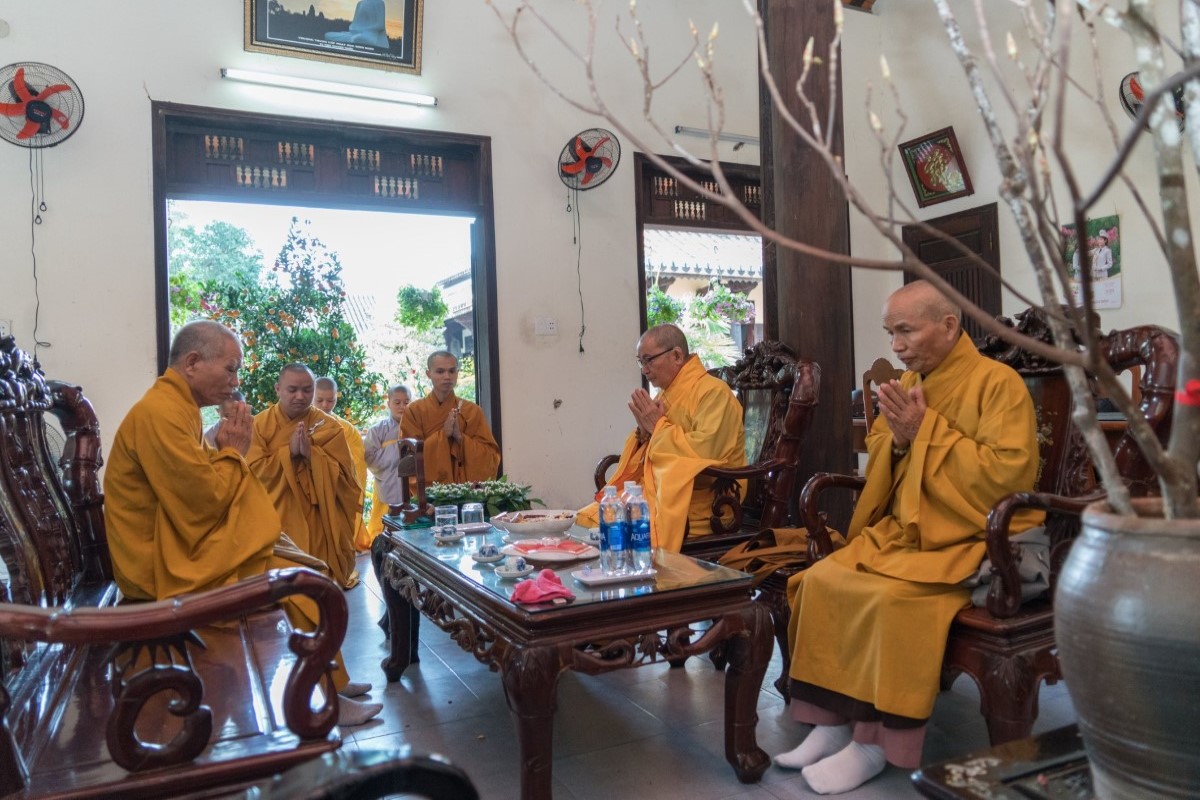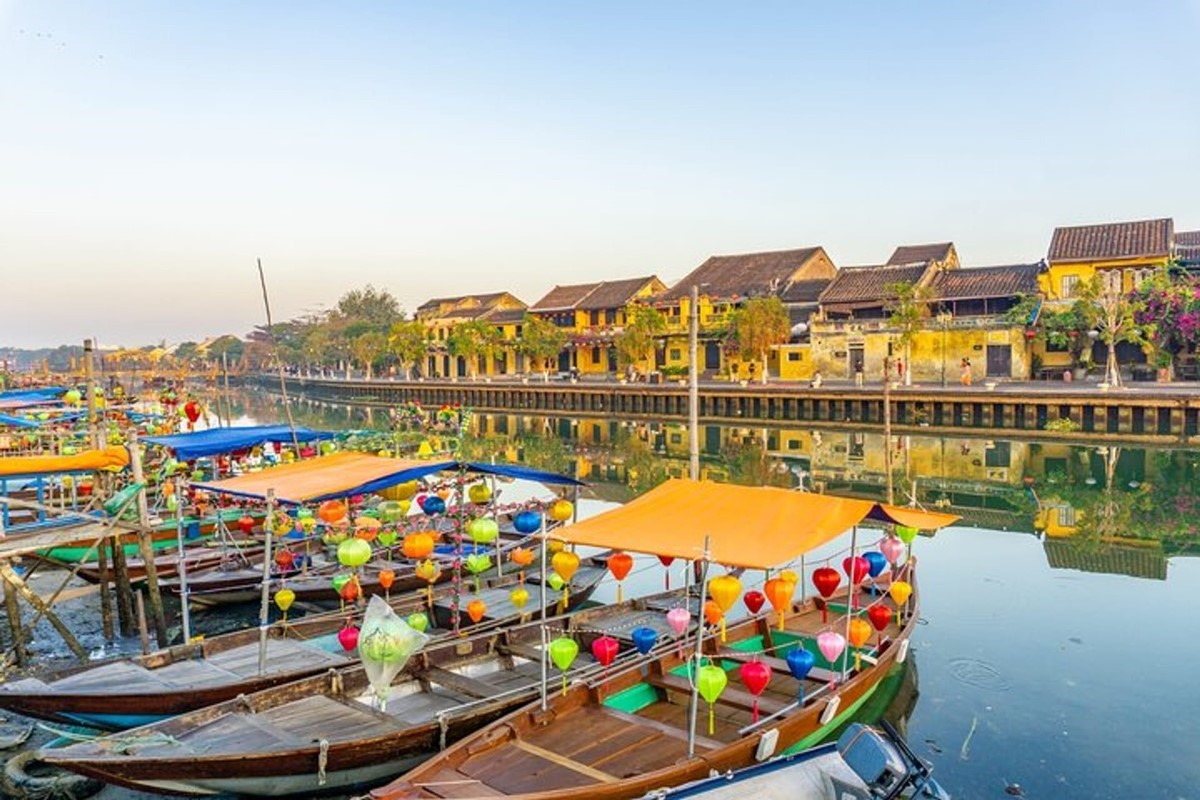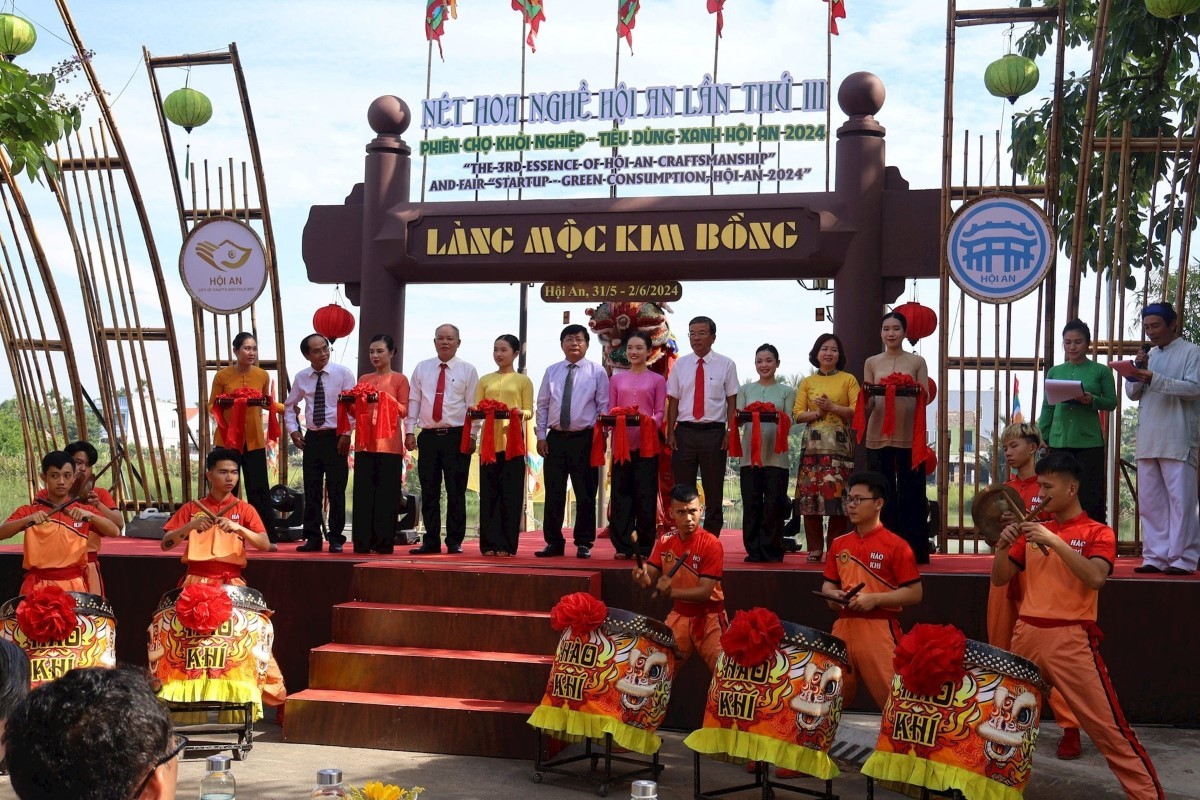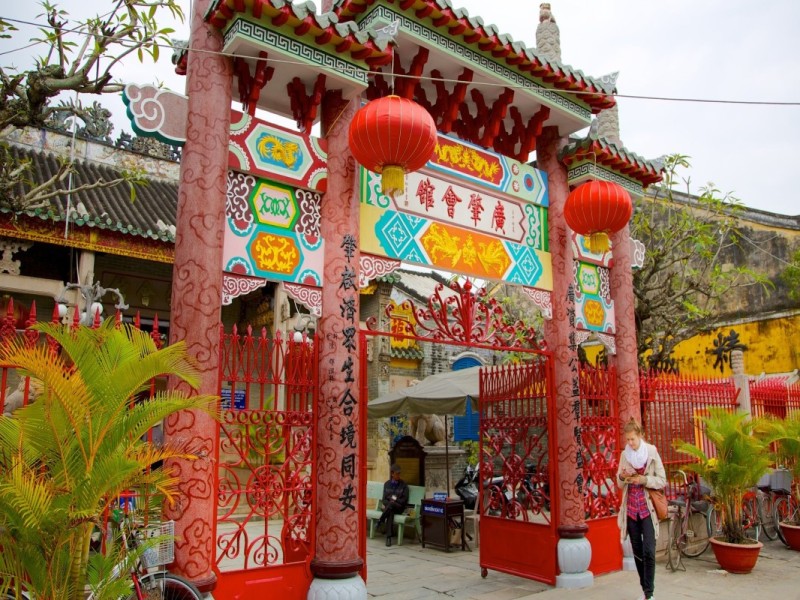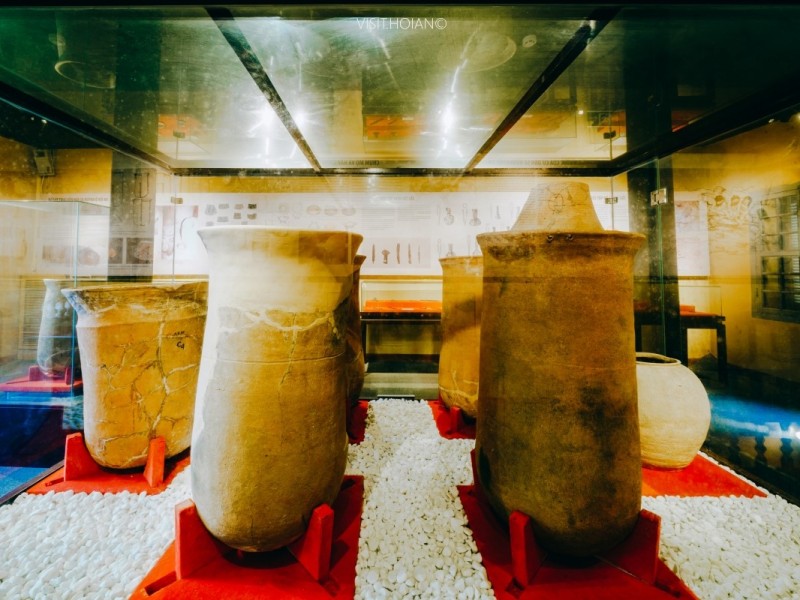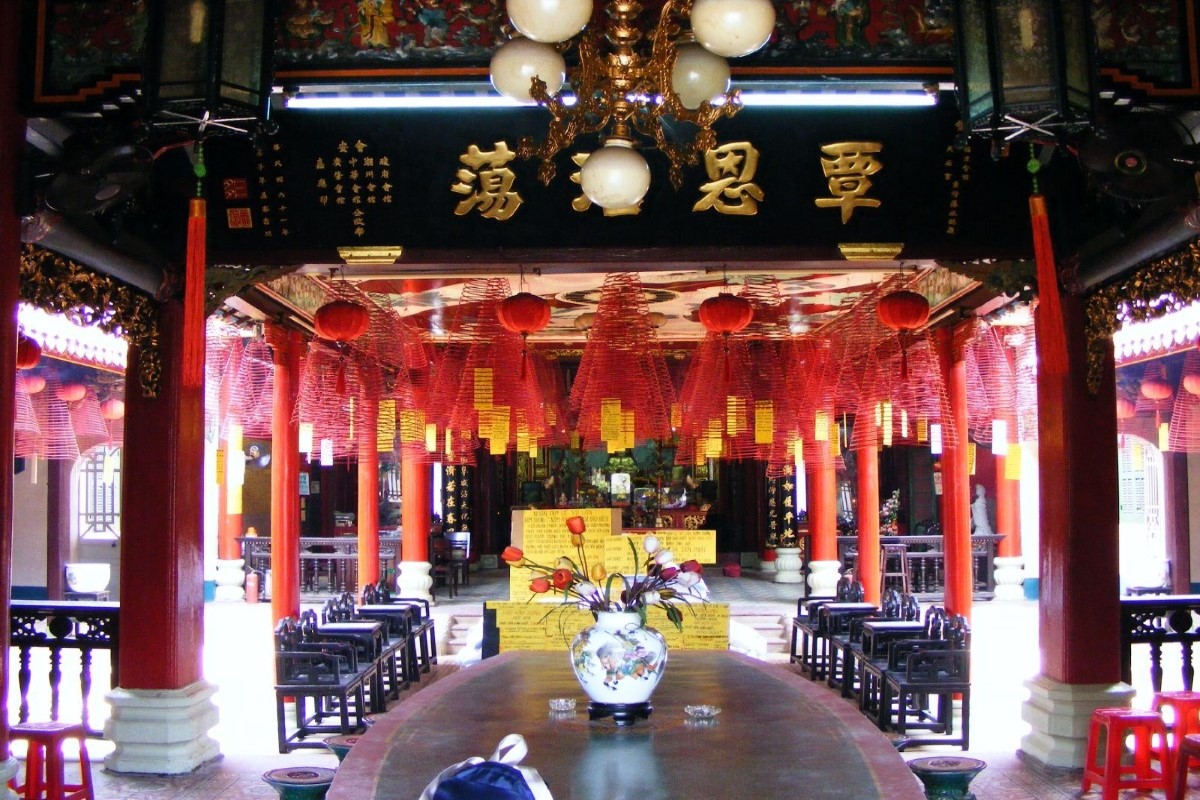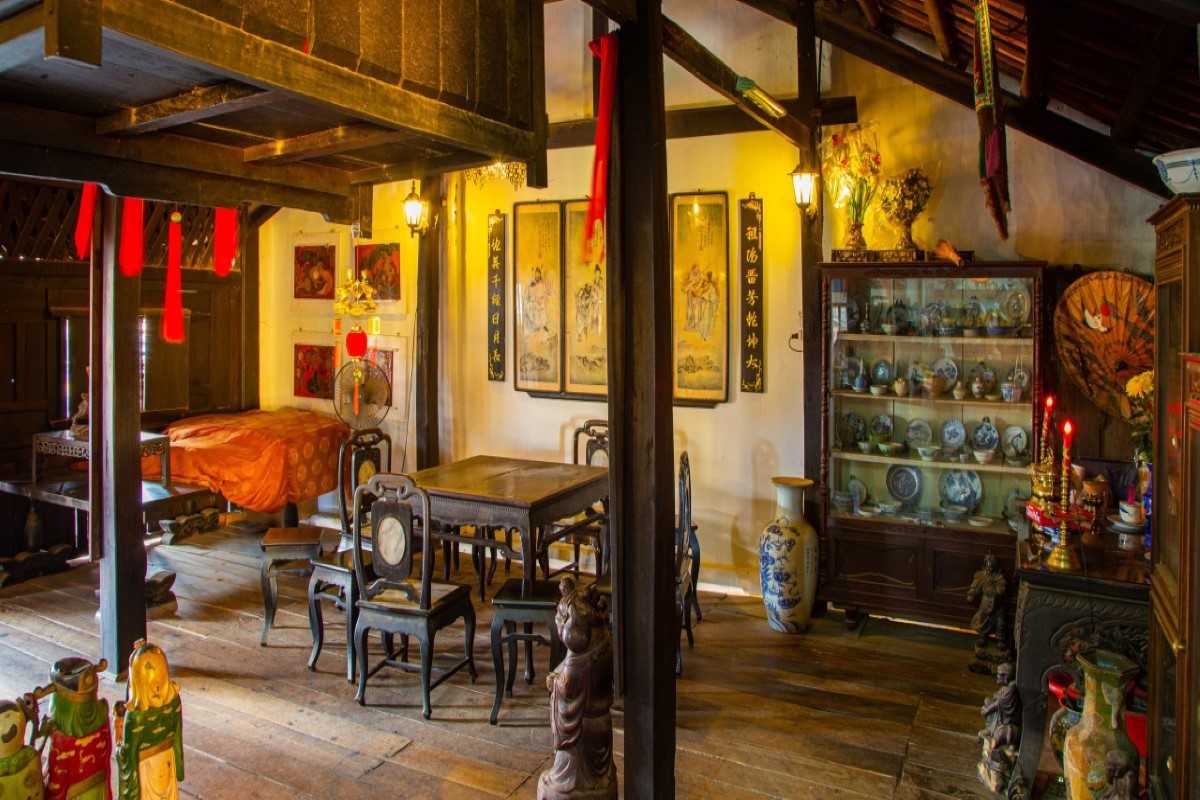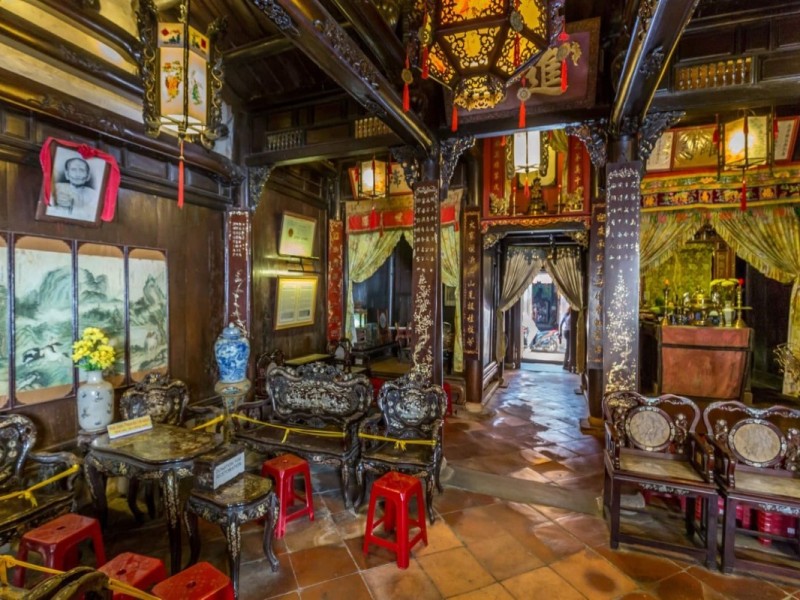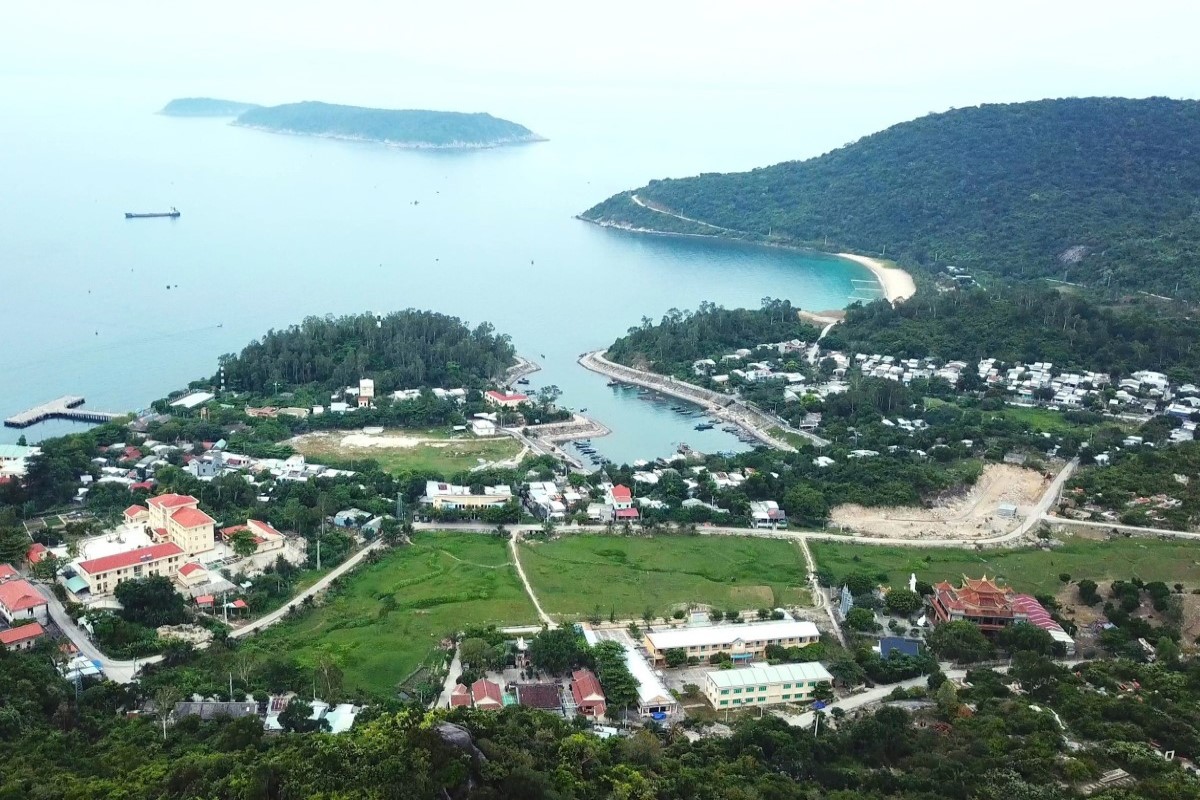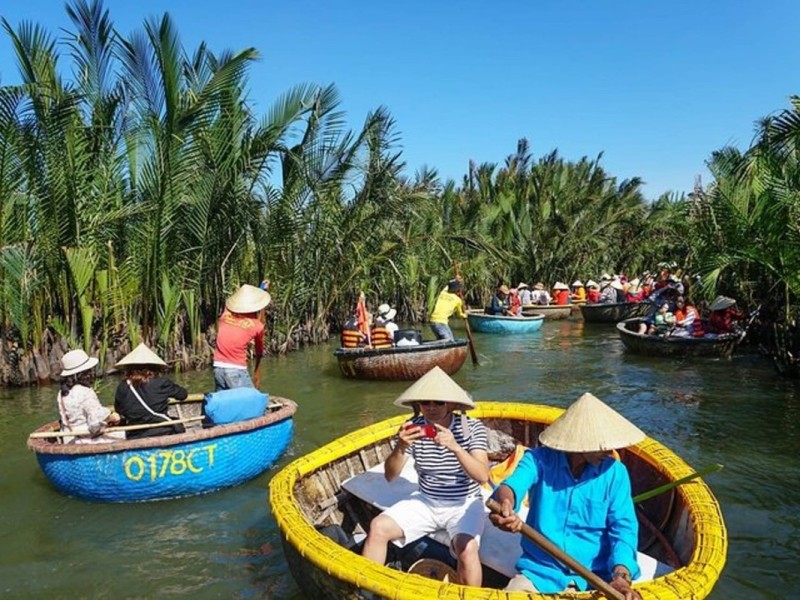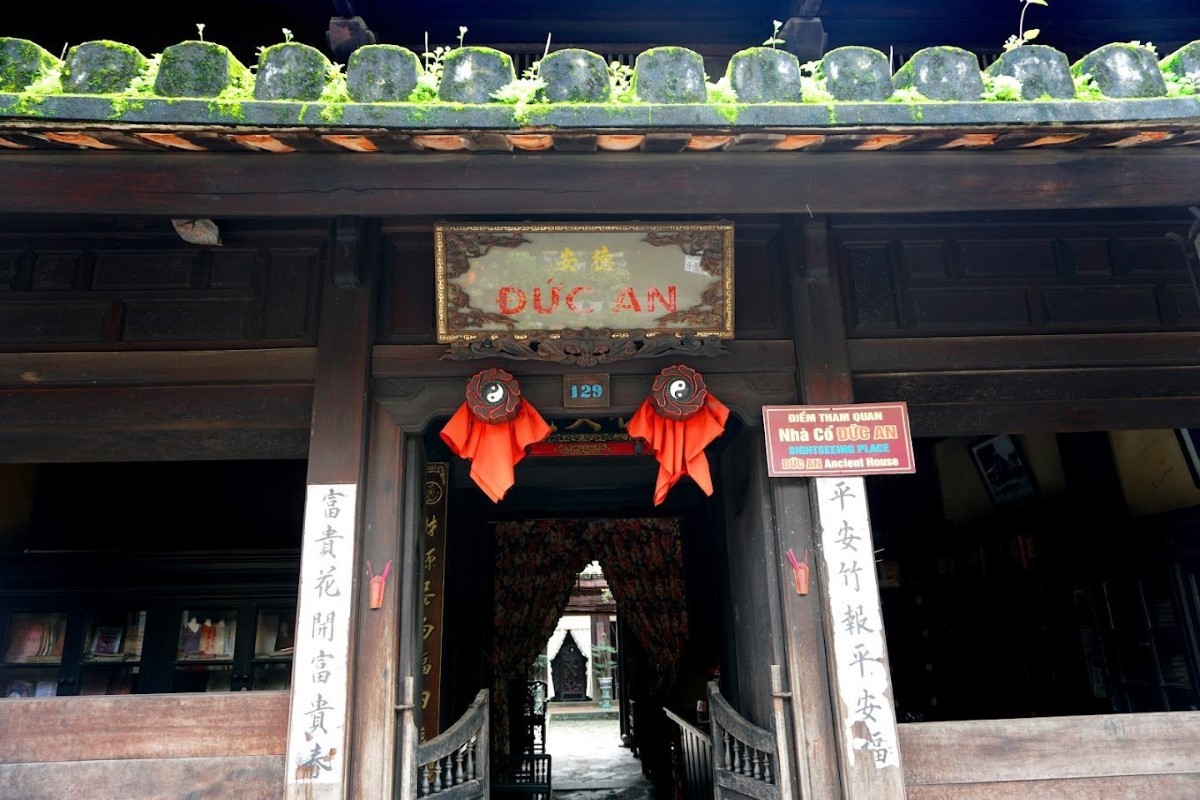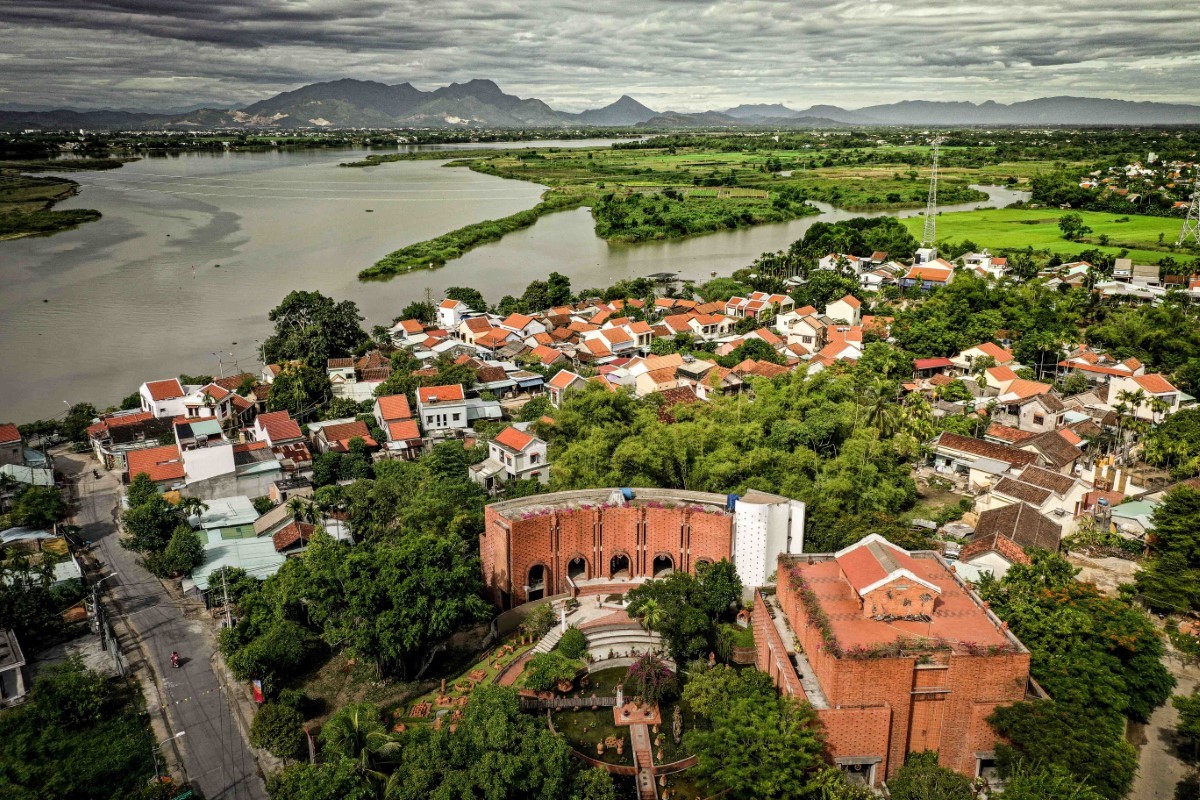Japanese Bridge Hoi An: History, Visitor Guide & Things to Do
The Japanese Bridge Hoi An is an iconic 17th-century covered bridge, featuring unique Japanese, Chinese, and Vietnamese architectural elements. It stands as a profound symbol of Hoi An's rich cultural heritage, housing a Taoist temple dedicated to warding off natural disasters. This historic landmark offers visitors a captivating blend of history, stunning photo opportunities, and a gateway to exploring the vibrant ancient town.
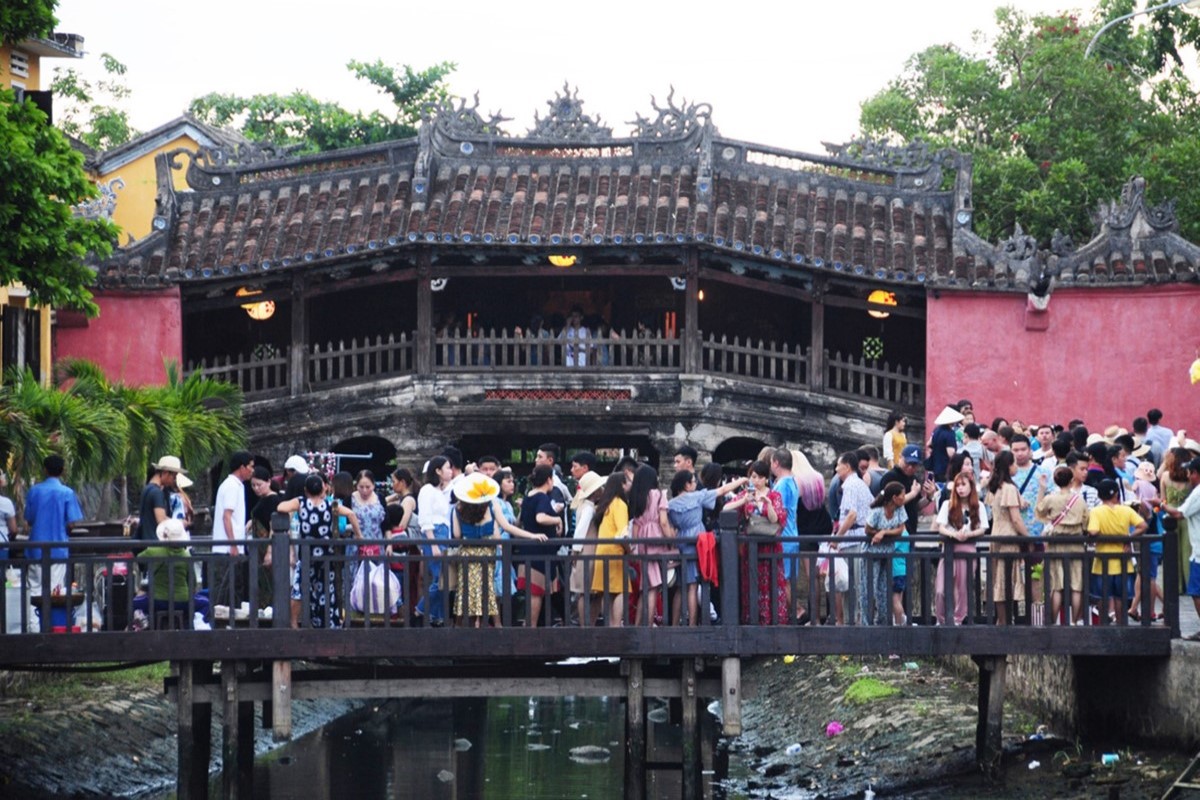
Introduction to the Japanese Bridge in Hoi An
Hidden meta description: Discover the charm and rich history of the Japanese Bridge in Hoi An, a cultural icon blending architecture and heritage.
The Japanese Bridge Hoi An is one of the most captivating landmarks in the ancient town. Its charm lies not only in its unique design but also in its deep historical roots that reflect centuries of cultural exchange. This covered bridge connects the Japanese and Chinese quarters, standing as a symbol of peace and harmony. As part of the UNESCO World Heritage-listed Hoi An, the bridge represents the rich cultural heritage of the town, attracting visitors from around the world eager to experience its allure.
Explore the historical background, cultural significance, and architectural beauty that make the Japanese Bridge Hoi An a must-see destination on any trip to Vietnam. Let this introduction inspire your curiosity about a site where history and culture flow as smoothly as the river beneath it.
Plan your visit to Japanese Bridge Hoi An and immerse yourself in the cultural heritage of this remarkable landmark.
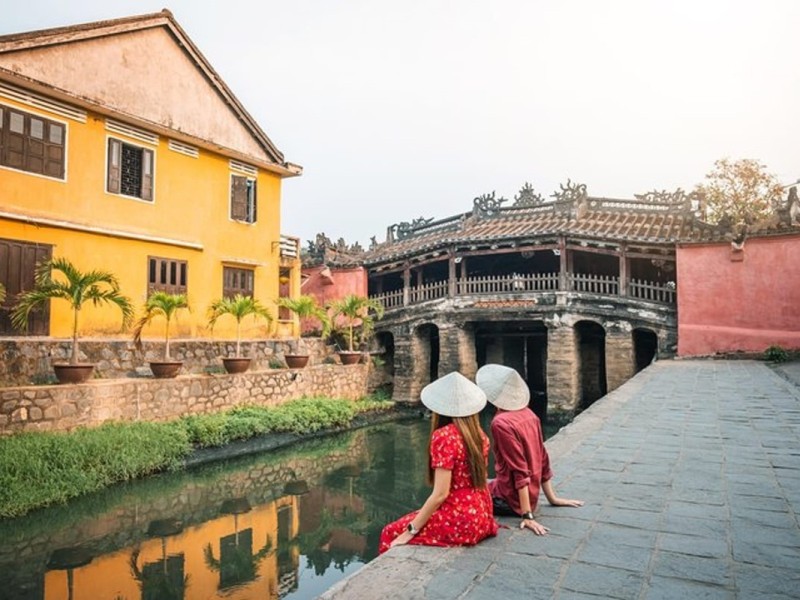
Overview of the Landmark
The Japanese Covered Bridge in Hoi An is a remarkable structure famed for its elegant covered walkway and intricate design. Built centuries ago, it remains a popular pedestrian attraction and a symbol of the town’s multicultural history. The bridge’s wooden beams and tiled roof provide shelter while crossing, creating a peaceful, almost timeless experience for visitors. Whether you stroll across it during the day or admire its silhouette at dusk, the bridge offers a glimpse into the harmony that once flourished between the Japanese and Chinese communities.
Visitors often note the serenity and charm that surrounds the bridge, making it a perfect spot for reflection and photography. With its rich history and pedestrian-friendly design, it continues to be a beloved feature of Hoi An’s Ancient Town.
End your visit with a walk across the Japanese Covered Bridge in Hoi An and capture memories of one of Vietnam’s most iconic landmarks.

Significance in Hoi An’s Cultural Heritage
The Japanese Bridge Hoi An stands as a testament to the town’s unique cultural crossroads, where Japanese, Chinese, and Vietnamese influences meet. It is more than a passageway; it is a symbol of harmony and cultural preservation. Recognized as part of the UNESCO World Heritage Hoi An Ancient Town, the bridge reflects centuries of trade, community, and shared traditions. Its preservation highlights the commitment to maintaining this cultural treasure.
Key heritage facts include:
- The bridge’s role in connecting distinct ethnic communities peacefully
- Its position as a living example of cultural synthesis in architecture
- The ongoing efforts to preserve its integrity within the Hoi An ancient town heritage zone
Understanding the cultural significance of the Japanese Bridge Hoi An enriches the visitor experience and deepens appreciation for Hoi An’s history.
Experience the cultural heritage of the Japanese Bridge Hoi An and explore its enduring legacy during your visit.
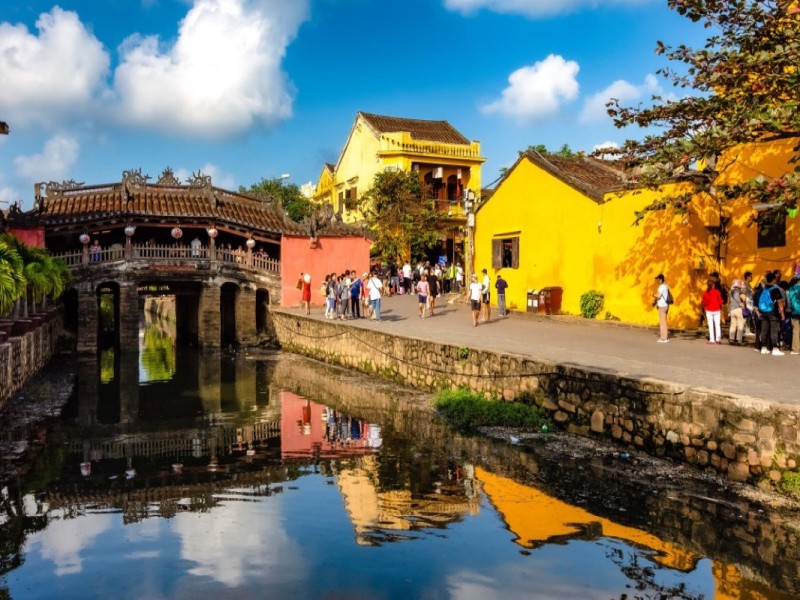
Unique Architectural Features
The architecture of the Japanese Bridge Hoi An showcases a remarkable blend of influences that speak to the town’s multicultural past. Its wooden pagoda roof, covered walkway, and symbolic animal statues make it architecturally distinct. Visitors can explore how Japanese traditional architecture integrates with Chinese roof tiles and Vietnamese decorative motifs, forming a harmonious whole that tells a story beyond the bridge itself.
The bridge’s design features are carefully crafted to reflect cultural dialogue and practical function, offering visitors insight into the historical craftsmanship of the region.
Discover the architectural marvels of the Japanese Bridge Hoi An and appreciate the fusion of styles that define its unique beauty.
Japanese Influences
This section highlights key elements of Japanese traditional architecture visible in the bridge’s design:
- Covered Walkway: A sheltered path providing shade and protection from rain
- Pagoda Roof: The characteristic curved wooden roof reflecting Japanese aesthetics
- Animal Statues: Monkeys and dogs guarding the bridge, symbolizing protection and mythology
These features emphasize the Japanese craftsmanship and cultural symbolism embedded in the bridge’s structure.
Explore the Japanese influences on the Japanese Bridge Hoi An to better understand its architectural heritage.
Chinese and Vietnamese Elements
The bridge also incorporates distinctive Chinese and Vietnamese design motifs that harmonize with its Japanese core:
- Chinese Roof Tiles: Traditional tiles that blend with the wooden roof structure
- Vietnamese Motifs: Decorative patterns reflecting local artistic styles
- Architectural Harmony: A seamless blend representing the multicultural spirit of Hoi An Ancient Town
These combined influences create a unique architectural dialogue that visitors can appreciate in detail.
Experience the cultural harmony of the Japanese Bridge Hoi An through its Chinese and Vietnamese design elements.
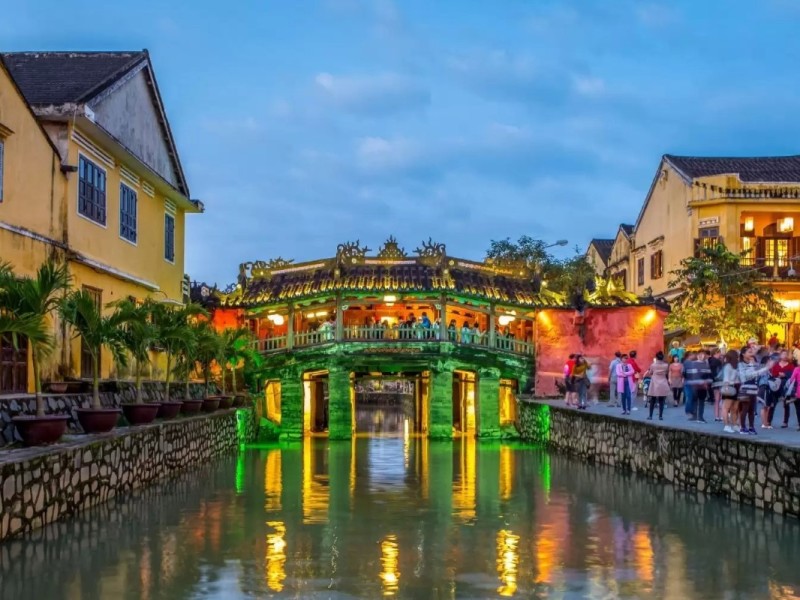
Historical Background of the Japanese Bridge
The Japanese Bridge Hoi An carries a rich history dating back to the 17th century, when it was built to connect the Japanese and Chinese quarters of the bustling Hoi An trade port. This strategic construction symbolized the town’s role as a multicultural trading hub in Southeast Asia. Beyond serving as a practical passage, the bridge embodies the cultural symbolism of peaceful coexistence and collaboration among diverse communities. Today, its preservation reflects ongoing respect for local artisanship and conservation techniques that protect its wooden structure and Taoist elements.
Delve into the origins, community influences, and restoration efforts that have safeguarded this emblematic landmark through centuries. Explore how legends such as the Namazu earthquake story add depth to its cultural narrative.
Plan your visit to the Japanese Bridge Hoi An and discover the living history preserved within its timeless architecture.

Origins and Construction in the 17th Century
The Japanese Bridge Hoi An was constructed in the early 1600s to link the separate Japanese and Chinese quarters in the vibrant port town of Hoi An. Its creation coincided with the town’s peak as a major trading center, attracting merchants from across Asia. The bridge’s covered wooden design offered both protection and a symbolic connection between distinct cultures.
Key facts include:
- Built during the 17th century amid flourishing maritime trade
- Served to connect Japanese and Chinese merchant communities
- Designed as a covered bridge with a small Taoist temple for spiritual protection
Understanding the bridge’s origins reveals much about Hoi An’s role in regional commerce and cultural exchange during that era.
Discover the historical roots of the Japanese Bridge Hoi An and its significance in linking diverse communities.
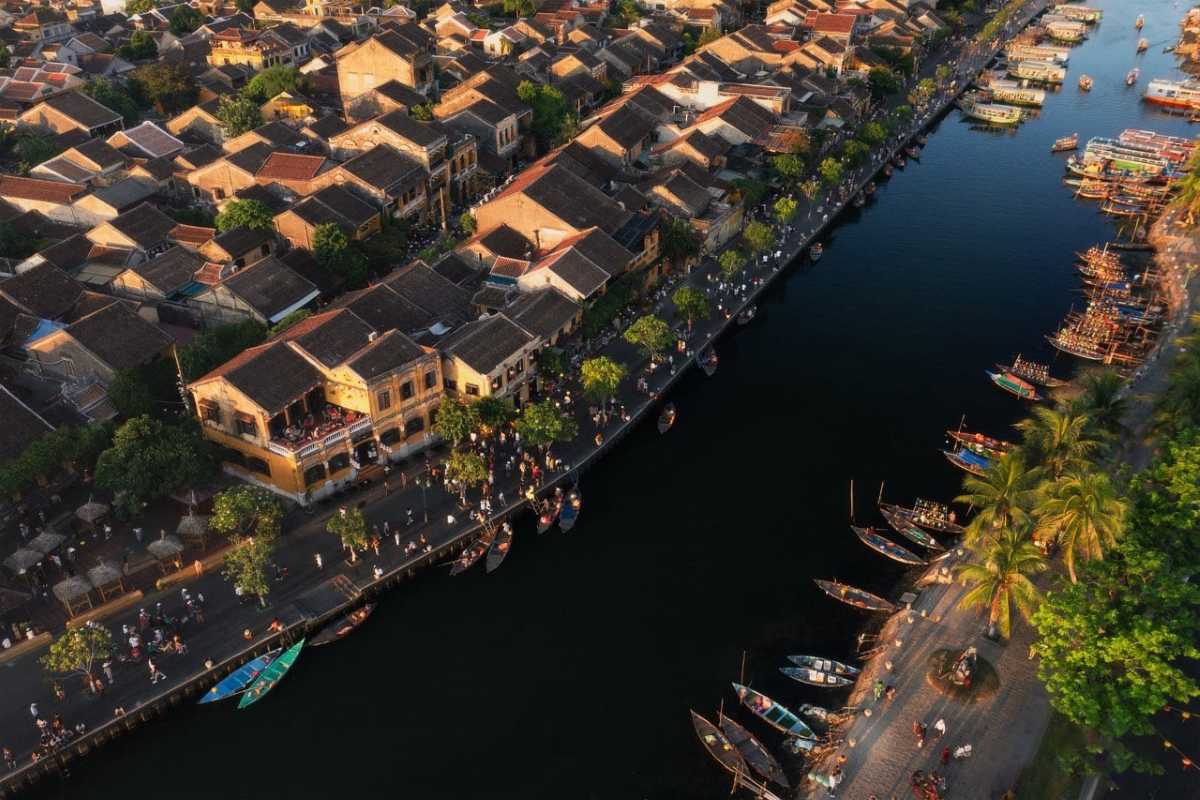
Role of the Japanese Community in Hoi An
The Japanese community in Hoi An played a vital role in the town’s history as traders and cultural contributors during the 17th century. Their presence influenced the design and purpose of the Japanese Bridge Hoi An, which became a physical and symbolic link between different ethnic quarters. Over time, political changes led to the gradual departure of many Japanese residents, but their legacy endures in the architecture and cultural fabric of the town.
Key points include:
- Japanese merchants’ influence on trade and town development
- The bridge as a symbol of multicultural harmony
- The eventual decline and departure of the Japanese community
Appreciating the human stories behind the Japanese Bridge Hoi An enriches your understanding of this multicultural heritage site.
Experience the bridge not only as an architectural marvel but as a testament to the vibrant history of Hoi An’s Japanese community.

Symbolism and Religious Importance
The symbolism of Japanese Bridge Hoi An reaches far beyond its architectural beauty, embodying deep cultural and religious meanings that enrich its significance. At the heart of the bridge lies a small Taoist temple, dedicated to Bac De Tran Vo, the Northern God of Taoism, believed to protect the bridge and the town from natural disasters. This spiritual presence invites visitors to appreciate the bridge not just as a physical structure but as a guardian steeped in tradition.
The bridge’s design features protective statues of a monkey and a dog at its ends, which relate to local legends about the mythical earthquake-causing monster, Namazu. These statues symbolize balance and protection, offering a narrative that connects history, culture, and spirituality in one remarkable place.
Reflecting on these symbols deepens your understanding and appreciation of the Japanese Bridge Hoi An, revealing layers of meaning beyond its surface beauty.
Experience the spiritual symbolism of the Japanese Bridge Hoi An to enrich your visit with cultural depth.
The Taoist Temple on the Bridge
The temple on the Japanese Bridge Hoi An is dedicated to Bac De Tran Vo, the Northern God of Taoism. It serves a protective spiritual role, believed to guard against earthquakes and other natural disasters.
Key features include:
- Dedication to Bac De Tran Vo, a Taoist deity responsible for protection
- Small altar area used for offerings and prayers
- Integration within the bridge’s structure symbolizing harmony between spirituality and daily life
This temple highlights the religious importance embedded in the bridge’s design and cultural heritage.
Discover the sacred role of the Taoist temple on Japanese Bridge and its place in local belief.
Protective Statues and Their Meanings
At the entrances of the Japanese Bridge Hoi An, statues of a monkey and a dog stand as symbolic guardians. According to legend, these animals represent a cosmic battle against Namazu, a giant catfish-like monster believed to cause earthquakes.
Legend details:
- Monkey and dog statues placed to “pin down” Namazu and prevent disasters
- Symbolize vigilance, protection, and balance between forces
- Reflect ancient beliefs woven into the town’s architecture and daily life
These statues transform the bridge into a narrative of cultural protection and spiritual significance.
Explore the meaning behind the monkey and dog statues Japanese Bridge and their role in local folklore.
Anna's Aha Moment: Understanding the Dragon-Monkey Symbolism
During her visit to the Japanese Bridge Hoi An, Anna recalls her “aha moment” when she first learned about the earthquake monster Namazu and the protective statues. Initially puzzled by the unusual animal figures, a local guide’s explanation brought the legend to life, allowing her to feel a deeper connection to the bridge’s cultural layers.
She describes the atmosphere—the gentle river sounds, the intricate carvings, and the quiet reverence around the temple—that made the legend tangible. This personal insight transformed her visit from sightseeing into a meaningful cultural experience.
Anna’s story encourages visitors to look beyond appearances and engage with the rich heritage embodied by the Japanese Bridge Hoi An.
Let Anna’s experience inspire you to discover the hidden stories behind the Japanese Bridge Hoi An.
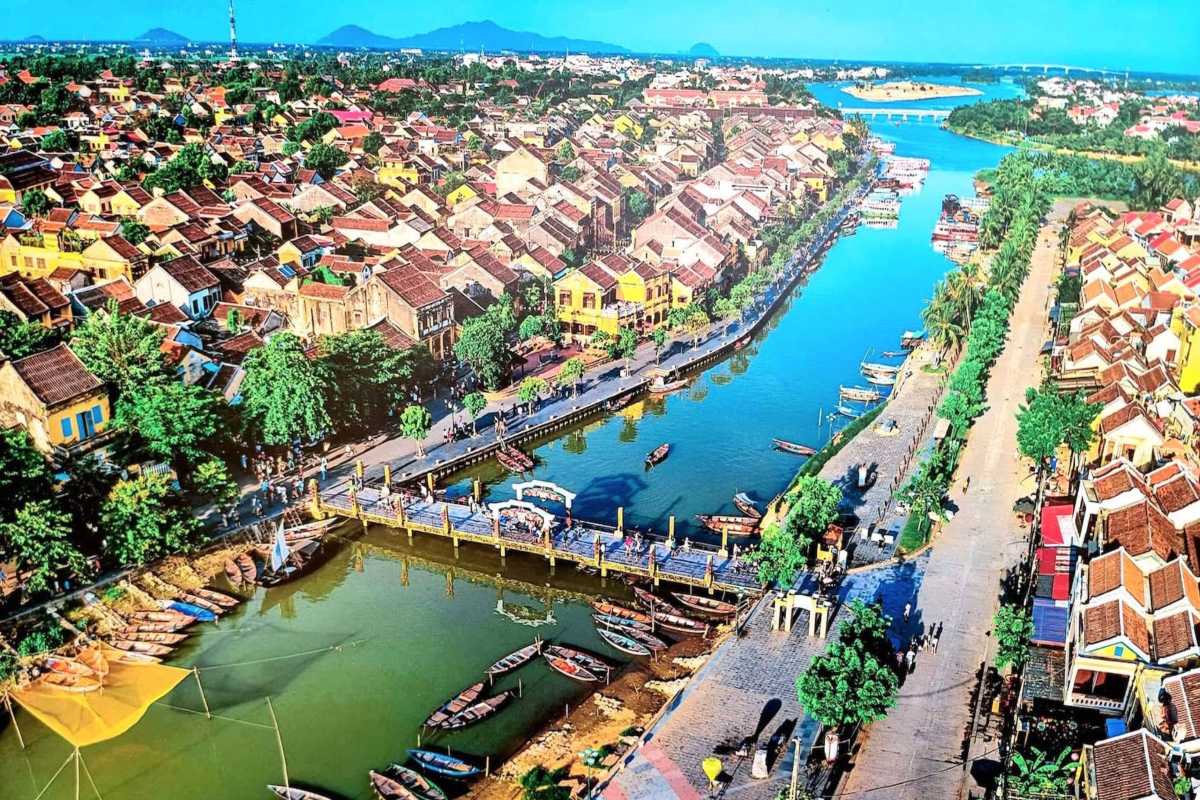
Restoration and Preservation History
The restoration of Japanese Bridge Hoi An reflects a long-standing commitment to preserving this cultural treasure. Over the centuries, the bridge has undergone multiple conservation projects aimed at maintaining its wooden structure and original design. These efforts ensure the bridge continues to stand as a symbol of Hoi An’s heritage and architectural ingenuity.
Restoration work balances preserving traditional craftsmanship with modern techniques, emphasizing sustainability and respect for the original materials. Understanding these projects highlights the dedication required to protect a heritage site exposed to natural wear and the impacts of tourism.
Appreciate the ongoing care behind the Japanese Bridge Hoi An and the intricate preservation work that keeps it vibrant for future generations.
Key Restoration Projects
Significant restoration milestones for the Japanese Bridge Hoi An include:
- 1986 Restoration: Major repairs focused on replacing deteriorated wood while retaining traditional joinery techniques
- 1990s Conservation Efforts: Reinforcement of the pagoda roof and replacement of worn tiles with authentic materials
- Early 2000s Maintenance: Structural stabilization addressing weather and tourist impact
These projects demonstrate a careful balance of historical accuracy and structural integrity.
Learn about the key restoration projects that have preserved the Japanese Bridge Hoi An through time.
Conservation Techniques Used
Preserving the Japanese Bridge Hoi An involves specialized techniques such as:
- Using locally sourced wood treated to resist moisture and pests
- Employing traditional carpentry methods without nails to maintain authenticity
- Applying natural preservatives to wooden surfaces for durability
- Regular inspections and maintenance schedules to monitor wear
These methods respect the bridge’s heritage while adapting to modern preservation needs.
Discover the conservation techniques that protect the Japanese Bridge Hoi An from decay.
Stories Behind the Bridge’s Restoration
Local artisans and historians share insights about the bridge’s restoration:
- An artisan recalls the challenge of replicating centuries-old joinery during the 1986 restoration
- Historians recount discovering hidden carvings and inscriptions beneath worn layers of wood
- Community members emphasize the bridge’s role as a living heritage symbol, inspiring restoration dedication
These stories bring human connection to the bridge’s preservation journey.
Experience the restoration stories that deepen appreciation for the Japanese Bridge Hoi An’s enduring legacy.

Deeper Dive: Unraveling the Symbolism & Stories
The Japanese Bridge Hoi An holds a deeper meaning beyond its physical structure, woven with spiritual and mythical significance. Positioned with geomantic precision, the bridge is said to act as a cosmic sword pinning down Namazu, a legendary earthquake monster whose restless movements were believed to cause natural disasters across Asia. This myth intertwines with the bridge’s cultural folklore, enhancing its importance as a symbol of protection and balance.
Local legends, like that of Namazu, enrich the visitor experience by connecting the bridge’s architecture with ancient beliefs and cosmic harmony. The blending of Japanese, Chinese, and Vietnamese architectural styles reflects a profound cultural dialogue that has shaped Hoi An’s unique heritage.
Explore the cosmic and mythical layers that give the Japanese Bridge Hoi An its timeless cultural resonance.
Plan your visit to uncover the stories and symbolism behind the Japanese Bridge Hoi An.

The Geomancy and Cosmic Significance
The geomantic significance of Japanese Bridge Hoi An lies in its symbolic role as a protective sword, believed to pin down the earthquake monster Namazu. According to local myth, Namazu’s thrashing caused devastating earthquakes, and the bridge’s placement was carefully chosen to suppress this force and safeguard the region.
This spiritual belief ties into the broader tradition of cosmic protection and architectural symbolism, blending folklore with practical geographic understanding. The bridge thus serves not only as a passageway but as a guardian of peace and stability.
Discover how the Japanese Bridge Hoi An embodies cosmic balance and cultural protection.
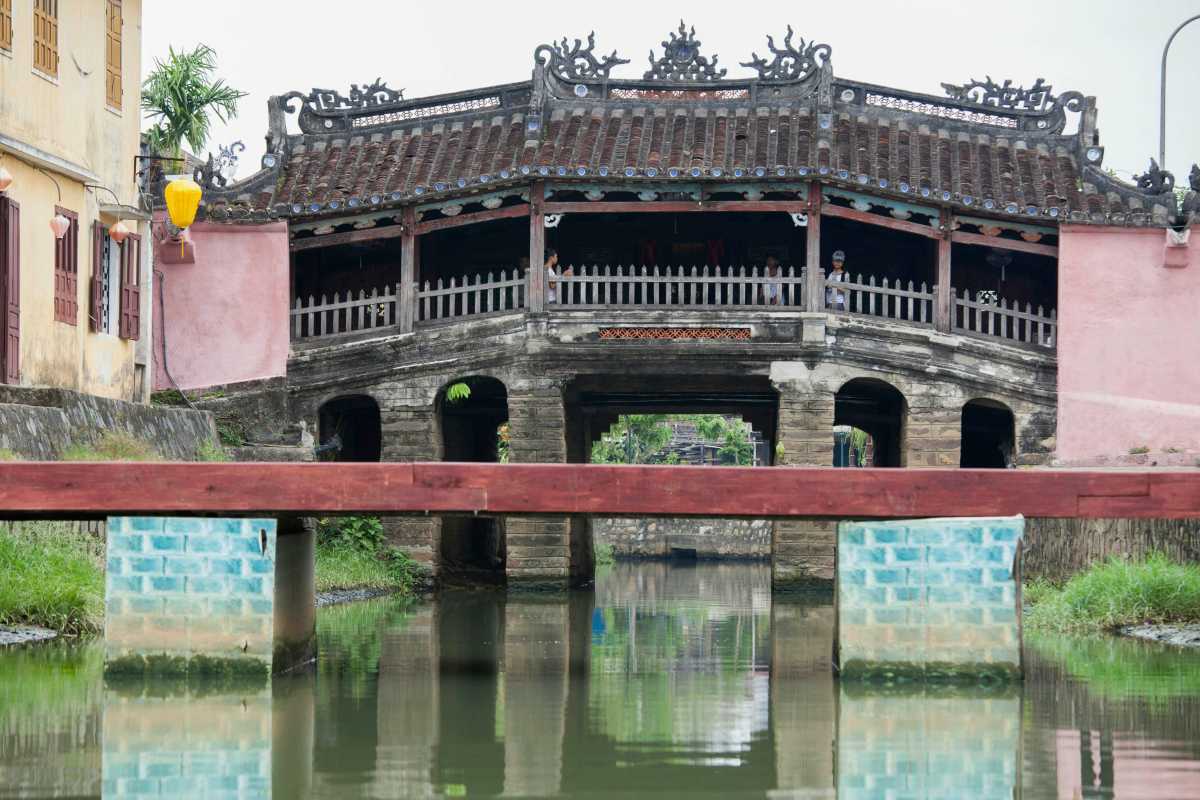
Legends and Local Lore
Local lore surrounding the Japanese Bridge Hoi An vividly recalls the Namazu earthquake monster and other stories that weave spirituality into the bridge’s identity. These legends speak of protective statues and spiritual guardians that watch over the town, reinforcing the bridge’s role as more than just an architectural marvel.
Such tales connect visitors emotionally to the site, making the history and culture tangible through storytelling and myth.
Immerse yourself in the rich Namazu earthquake monster legend and local myths that bring the Japanese Bridge Hoi An to life.
Hiroshi’s Humility: Reflecting on the Earthquake Monster Myth
Hiroshi, a traveler visiting the Japanese Bridge Hoi An, shares his reflective experience of learning about the Namazu legend. Initially skeptical, he found the story took on new meaning as he stood by the bridge, surrounded by its statues and serene atmosphere. The guide’s explanation revealed a cultural humility and respect for forces beyond human control.
This moment transformed his visit, fostering a personal connection to the bridge’s spiritual heritage.
Let Hiroshi’s story inspire you to engage deeply with the legends surrounding the Japanese Bridge Hoi An.
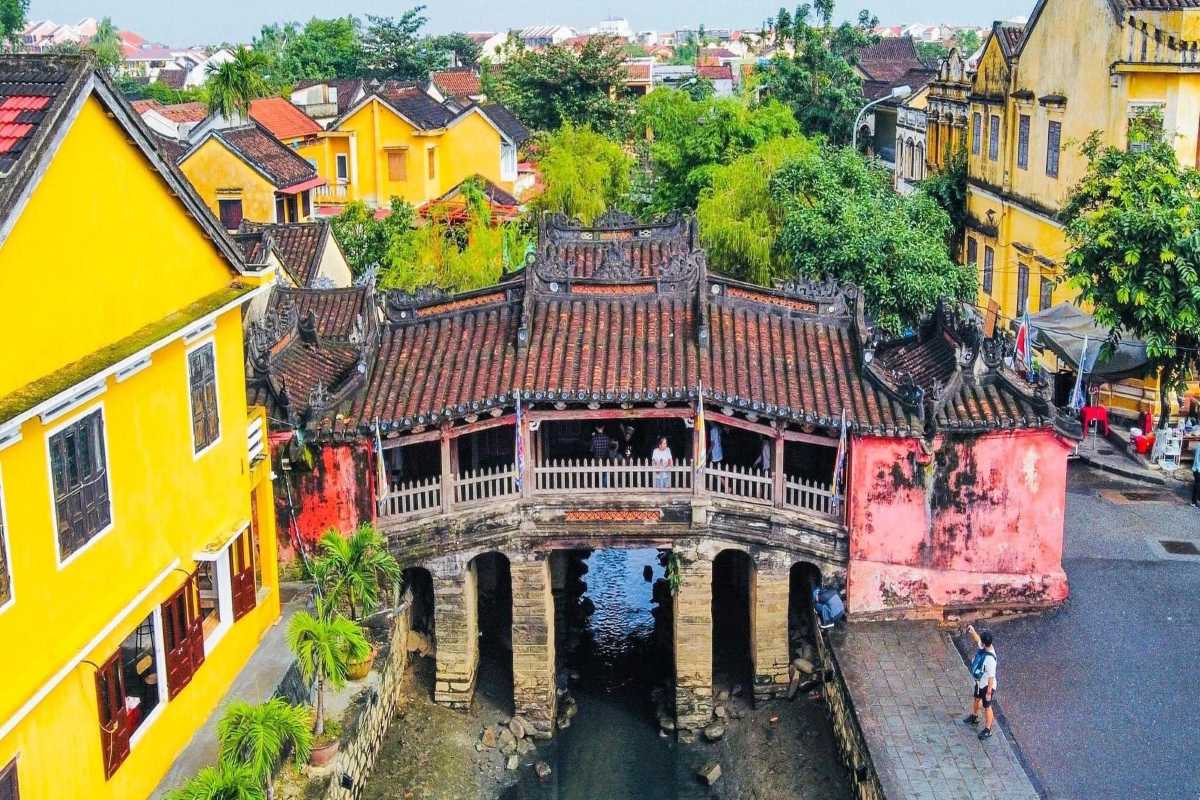
Architectural Dialogue: East Meets East
The Japanese-Chinese-Vietnamese architecture blend of the Japanese Bridge Hoi An is a testament to the multicultural history of Hoi An. This fusion showcases Japanese pagoda roofs, Chinese roof tiles, and Vietnamese decorative motifs working together in harmony. Each style contributes unique elements that tell the story of cultural interaction and mutual respect.
Key architectural features include:
- The wooden pagoda roof reflecting Japanese design
- Chinese-style roof tiles adding texture and durability
- Vietnamese motifs enhancing aesthetic richness
This architectural dialogue enriches the visitor’s appreciation of the bridge as a cultural and historical symbol.
Explore the multicultural design that makes the Japanese Bridge Hoi An an architectural treasure.
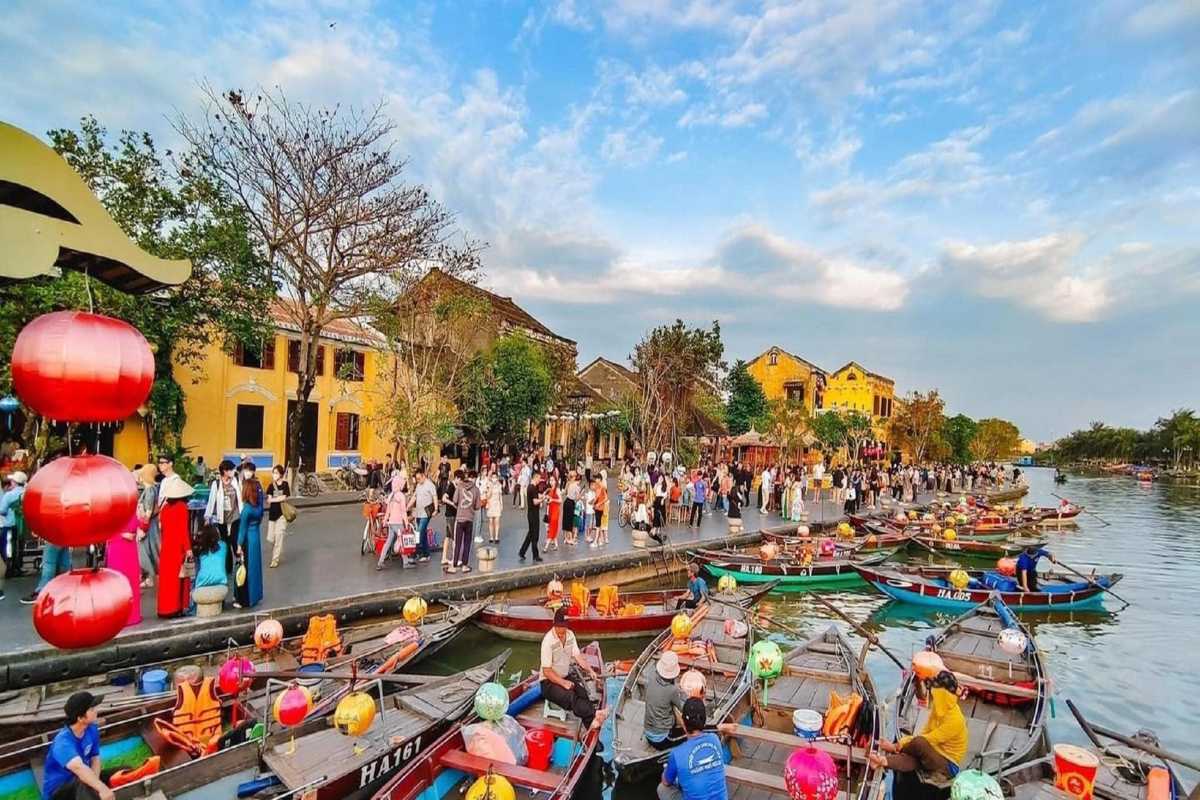
Practical Visitor Information
The Japanese Bridge Hoi An is easily accessible and well-integrated into the vibrant Hoi An Ancient Town, making it a convenient and rewarding visit. Whether you arrive from nearby Da Nang or other major cities, clear transportation options and detailed travel tips ensure a smooth journey. Understanding opening hours, ticket requirements, and the best times to visit will help you maximize your experience at this iconic cultural landmark.
Prepare for your visit with practical advice on navigating the town, local transportation, and seasonal considerations. Let these insights guide you to fully enjoy the Japanese Bridge Hoi An and its surroundings.
Plan your visit to the Japanese Bridge Hoi An with confidence using these essential travel tips.
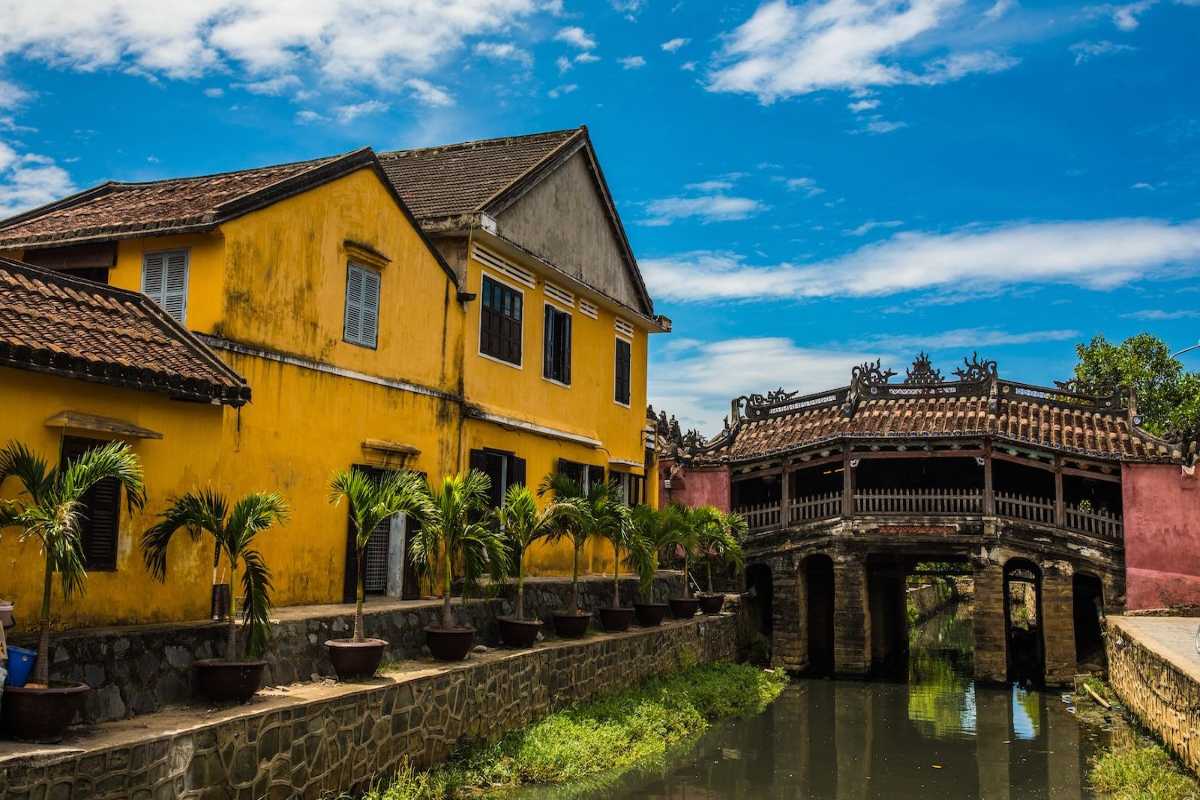
Location and How to Get There
Getting to the Japanese Bridge Hoi An is straightforward, whether you’re traveling from nearby cities or exploring within Hoi An itself. The bridge is centrally located in the Ancient Town, making it easily reachable by walking or local transport.
Key travel tips:
- How to get to Japanese Bridge Hoi An from Da Nang airport: take a taxi or shuttle bus, approximately 45 minutes, costing around $15-$20
- From Hanoi or Ho Chi Minh City (HCMC): fly into Da Nang, then follow local transport options
- Within Hoi An, the bridge is accessible on foot, by bicycle, or via cyclo rides
Knowing your options helps you plan the best route and mode of transport for your visit.
Explore efficient ways to reach the Japanese Bridge Hoi An and enjoy your journey with ease.
Address and Geographic Context
The Japanese Bridge Hoi An is located at Nguyễn Thị Minh Khai Street, Phường Minh An, Hoi An, Quảng Nam Province. It sits in the heart of the Hoi An Ancient Town, crossing a small canal that connects the Japanese and Chinese quarters. This central position makes it a key landmark easily accessible from any point in the Old Town.
Understanding its precise location helps visitors orient themselves and plan their walking routes accordingly.
Note the exact address and geographic setting when planning your visit to the Japanese Bridge Hoi An.
Getting There from Major Hubs (Da Nang, Hanoi, HCMC)
Traveling to Hoi An from major Vietnamese cities is convenient:
- From Da Nang Airport: take a taxi or shuttle bus directly to Hoi An (approx. 30-45 minutes)
- From Hanoi and HCMC: domestic flights to Da Nang Airport are frequent; from there, ground transport to Hoi An is available
- Train travel to Da Nang Station, then bus or taxi to Hoi An
- Bus services connect Hoi An with other cities, offering budget options
Estimated costs vary but are generally affordable, making Hoi An accessible for all travelers.
Plan your route efficiently to arrive relaxed and ready to explore the Japanese Bridge Hoi An.
Transportation Options Within Hoi An
Navigating Hoi An to reach the Japanese Bridge is easy with several local transport choices:
- Walking: The Old Town is compact and pedestrian-friendly
- Bicycle rentals: Popular and eco-friendly for exploring wider areas
- Cyclo rides: Traditional three-wheeled bicycle taxis offering a leisurely tour
- Electric buggies: Comfortable and convenient for longer distances
These options allow you to tailor your visit to your pace and preferences.
Choose the best local transportation in Hoi An for a comfortable visit to the Japanese Bridge Hoi An.

Opening Hours and Entry Fees
The Japanese Bridge Hoi An is accessible for viewing at all hours, with its exterior open 24/7 to the public. However, access to the interior temple area follows specific visiting times, typically between 8:00 AM and 5:00 PM. To enter the bridge’s temple and other historic sites within the Hoi An Ancient Town, visitors must purchase an Old Town ticket. This ticket grants admission to multiple attractions, including the bridge’s temple.
Current ticket prices generally range from 120,000 to 150,000 VND for adults, though prices may vary seasonally or with special events. Children under a certain age or local residents often receive discounts. Understanding these fees helps you prepare for a smooth visit.
Check updated Japanese Bridge Hoi An opening hours and ticket prices to plan your visit effectively.
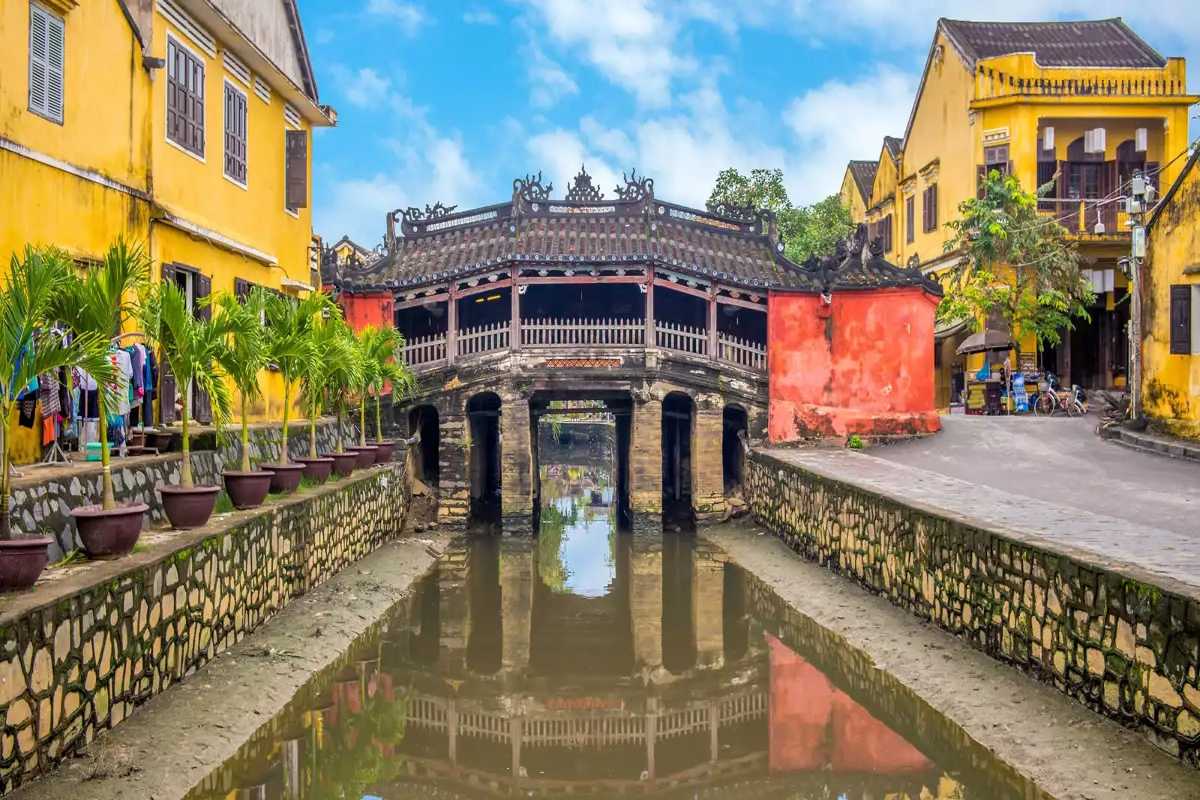
Best Times and Seasons to Visit
Choosing the best time to visit Japanese Bridge Hoi An significantly enhances your experience by ensuring comfortable weather and manageable crowds. The dry season, from February to August, offers sunny days ideal for exploring the bridge and Hoi An Ancient Town. Avoiding the wet season from September to January minimizes disruption from heavy rains.
Planning your visit around local events can add cultural richness, though some festivals, like the Lantern Festival, draw large crowds.
Follow these seasonal tips to enjoy the Japanese Bridge Hoi An at its finest.
Weather Considerations
Understanding Hoi An weather seasons helps visitors pack and plan properly. Key points include:
- Dry Season (Feb-August): Warm, sunny, best for outdoor activities
- Wet Season (Sept-Jan): High humidity and frequent showers, less crowded
- What to pack: Light clothing, sun protection, rain gear for wet season
Adapting your packing to the weather ensures comfort while exploring the Japanese Bridge Hoi An.
Prepare for your visit by knowing the weather in Hoi An and packing accordingly.
Festivals and Special Events Impacting Visits
The Lantern Festival Hoi An is a monthly event transforming the bridge area into a vibrant cultural celebration with floating lanterns and traditional performances. Other cultural events throughout the year highlight the town’s rich heritage, though they often increase visitor numbers and crowding around the bridge.
Planning your visit to coincide with or avoid these events can affect your experience.
Experience the magic of Hoi An cultural events while considering crowd levels around the Japanese Bridge Hoi An.
Liam’s Morning Stroll: Beating the Crowds at the Bridge
Liam shares his secret to enjoying the Japanese Bridge Hoi An peacefully: arriving early, around 6 AM, when the town is still quiet and bathed in soft morning light. This time offers serene views of the bridge and a chance to absorb the atmosphere without the usual crowds and noise.
His morning stroll revealed a different side of the bridge—framed by golden light and gentle river sounds—creating a memorable, intimate experience.
Try visiting early to enjoy the Japanese Bridge Hoi An with calm and clarity.

Accessibility and Visitor Facilities
The Japanese Bridge Hoi An strives to accommodate visitors of all abilities, though some limitations exist due to its historic structure. Accessibility features and visitor amenities are designed to support a comfortable and safe experience.
Key accessibility and facility details include:
- Limited wheelchair access due to narrow pathways and wooden steps
- Smooth walking routes nearby for easier navigation
- Availability of nearby restrooms within the Hoi An Ancient Town
- Information kiosks offering guidance and maps
- Seating areas around the bridge for rest and relaxation
Being informed about these facilities helps visitors plan accordingly and ensures everyone can enjoy the site comfortably.
Check accessibility options and visitor facilities when planning your visit to the Japanese Bridge Hoi An.
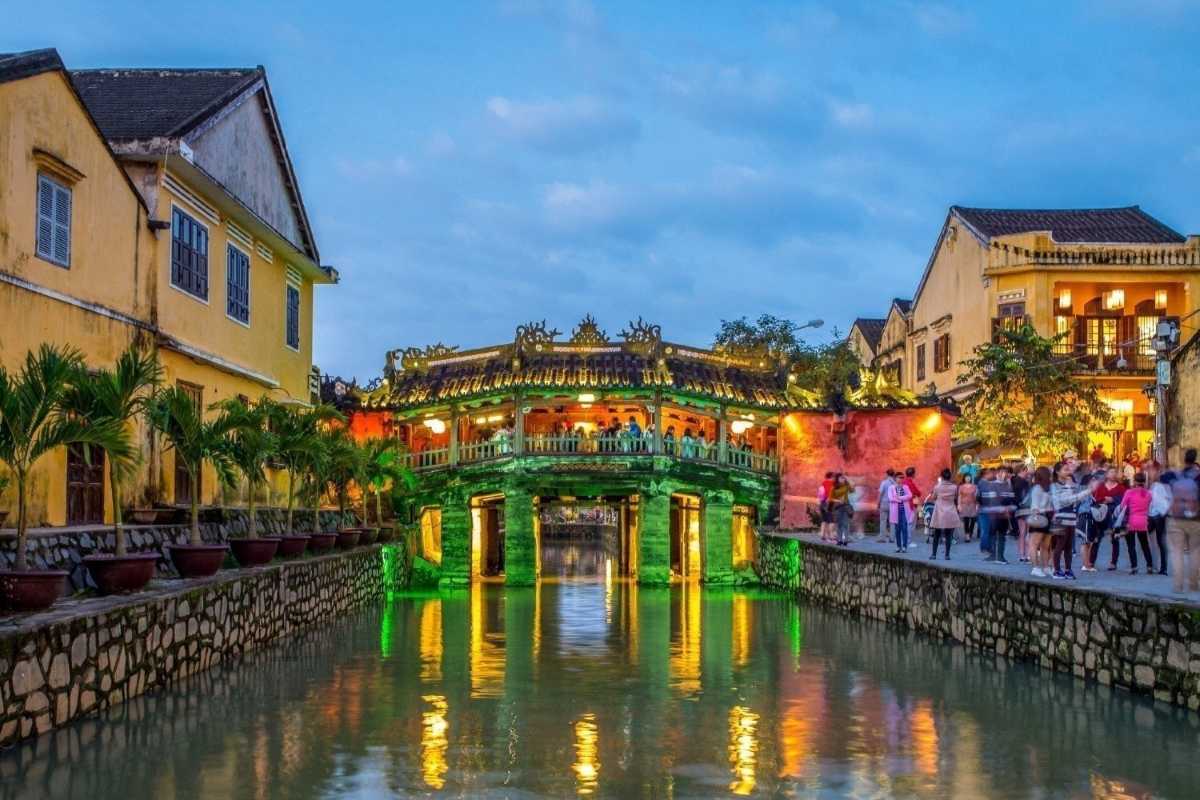
What to Wear and Bring
Preparing for your visit to the Japanese Bridge Hoi An involves practical packing and respectful attire, especially when entering the temple area.
Essential packing and clothing tips:
- Wear comfortable walking shoes suitable for wooden and uneven surfaces
- Bring sun protection such as hats and sunscreen due to outdoor exposure
- Dress modestly with shoulders and knees covered when visiting the temple
- Carry a camera to capture the bridge’s beauty
- Pack water and light snacks for comfort during exploration
Following these guidelines ensures both a pleasant visit and respect for local customs.
Prepare your essentials with these what to wear Japanese Bridge Hoi An and packing tips for a smooth, respectful visit.
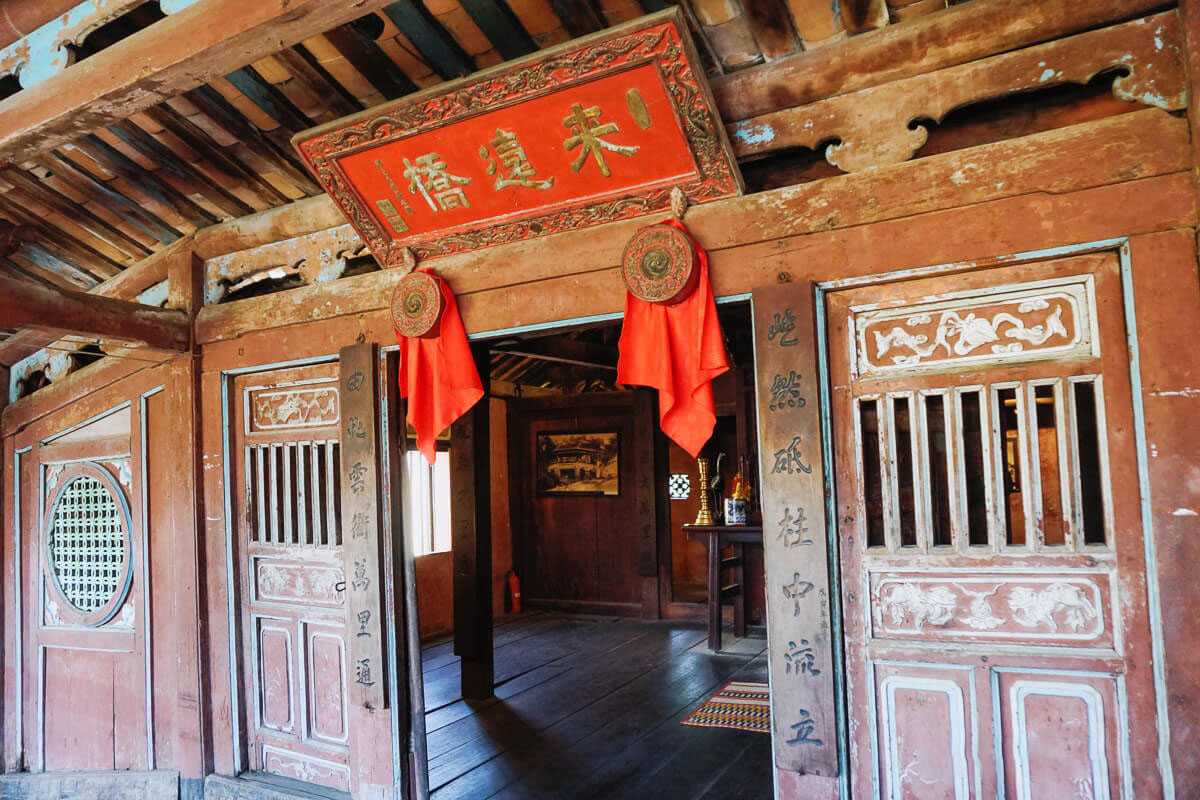
Planning Your Visit: Essential Tips for a Seamless Experience
Planning your visit to the Japanese Bridge Hoi An ensures a comfortable, respectful, and memorable experience. Knowing the best times to go, how to navigate the Ancient Town, what to wear, and how to budget for entrance fees will help you avoid crowds, stay safe, and immerse yourself in the local culture. Being aware of common scams also protects your visit from unwanted surprises.
Use these practical tips to confidently explore the Japanese Bridge Hoi An and its vibrant surroundings.
Prepare your itinerary thoughtfully and enjoy every moment of your visit to the Japanese Bridge Hoi An.
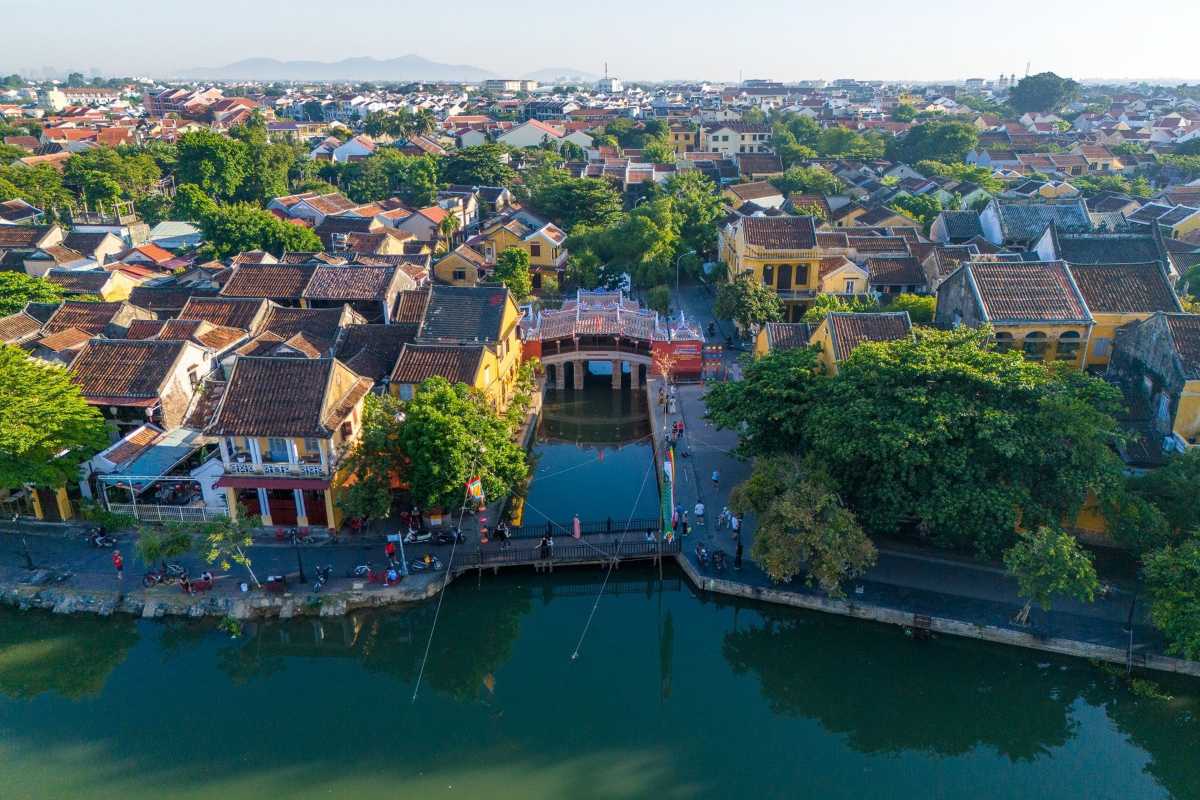
Best Time to Go: Avoiding Crowds and Enjoying the Weather
Choosing the best time to visit Japanese Bridge Hoi An helps you enjoy pleasant weather and fewer tourists. The dry season from February to August offers warm, sunny days ideal for exploring. Avoid peak festival times like the Lantern Festival if you prefer quieter visits. Early mornings and late evenings provide calm atmospheres with beautiful lighting.
Plan your visit around these tips to maximize comfort and enjoyment.
Discover how timing your trip enhances the Japanese Bridge Hoi An experience.
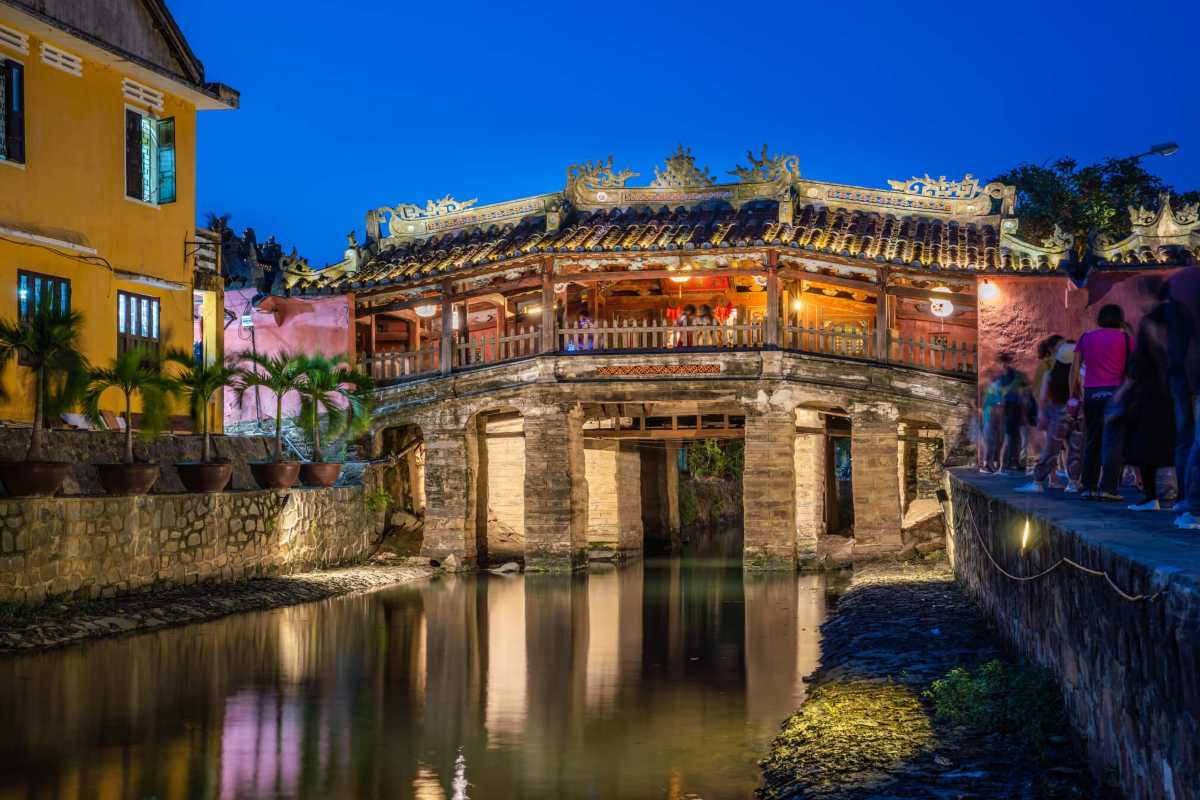
Navigating Hoi An: Transportation within the Ancient Town
Getting around Hoi An Ancient Town to reach the Japanese Bridge Hoi An is simple with several transport options:
- Walking: The Old Town is compact and pedestrian-friendly
- Bicycle rentals: Popular for flexible exploration
- Cyclo rides: Traditional, slow-paced tours ideal for sightseeing
- Electric vehicle tours: Comfortable for longer distances
Each mode offers unique advantages depending on your pace and preferences.
Choose the best transportation for a smooth visit to the Japanese Bridge Hoi An.
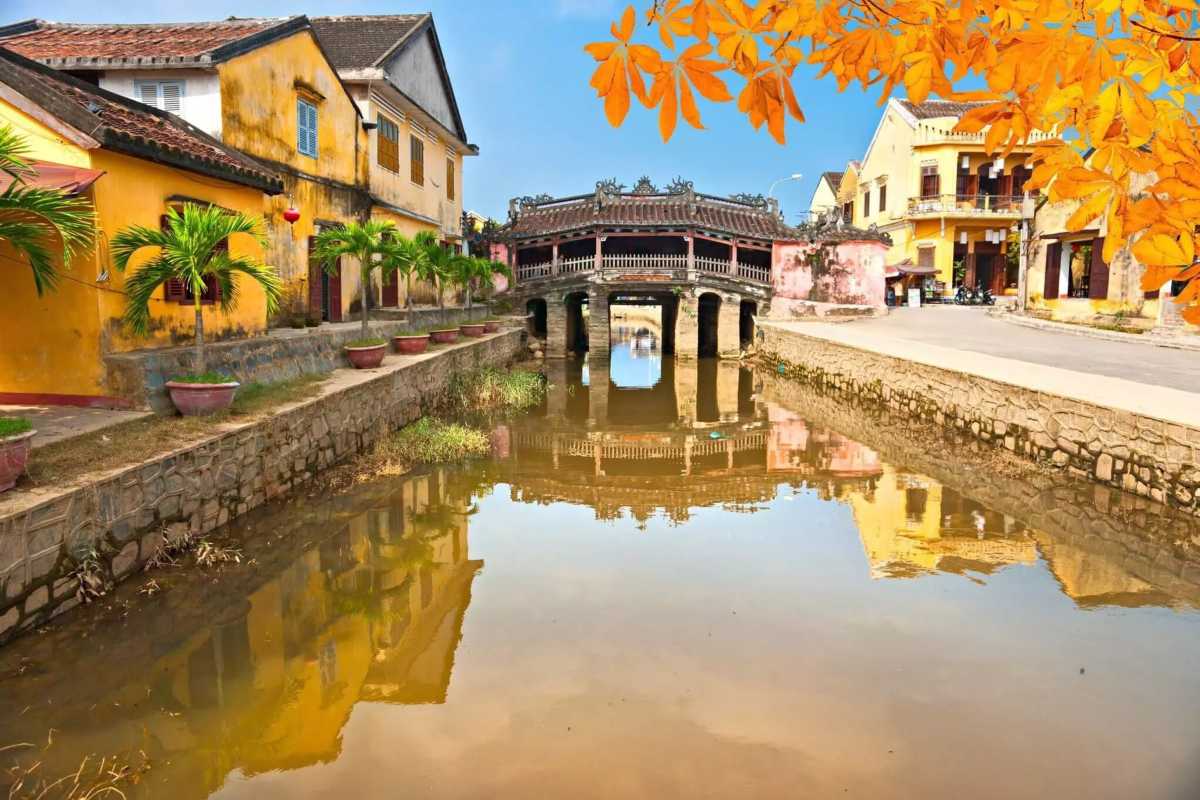
What to Wear and Bring
Packing appropriately for the Japanese Bridge Hoi An visit ensures comfort and cultural respect. Essentials include:
- Comfortable walking shoes for wooden and uneven surfaces
- Sun protection such as hats and sunscreen
- Modest clothing covering shoulders and knees when entering the temple
- A camera to capture stunning views
- Water and light snacks for refreshment
These items help you stay comfortable and honor local customs.
Prepare your visit with these practical what to wear Japanese Bridge Hoi An and packing tips.

Budgeting for Your Visit: Entrance Fees & More
Understanding the costs associated with visiting the Japanese Bridge Hoi An helps you plan your budget. The Old Town ticket system covers entrance to the bridge’s temple and other heritage sites, typically costing around 120,000 to 150,000 VND. Additional expenses include food, drinks, and transport within the town.
Budget wisely to enjoy the Japanese Bridge Hoi An and surrounding attractions without surprises.
Plan your spending with clear insights on entrance fees and local costs.

Common Scams to Watch Out For
Be aware of common tourist scams in Hoi An, especially around popular sites like the Japanese Bridge. Watch for:
- Overcharging by cyclo drivers or taxi operators
- Pushy vendors selling fake or overpriced goods
- Unofficial ticket sellers and misleading offers
Stay alert and verify prices beforehand to avoid these pitfalls.
Protect your visit by knowing these common tourist scams in Hoi An.

Cultural Sensitivity & Etiquette
Showing respect and understanding of local customs enhances your visit to the Japanese Bridge Hoi An and helps maintain the site’s cultural integrity. Visitors should be aware of appropriate behavior to avoid offending locals and preserve the sacred atmosphere of the bridge and its temple.
Key cultural etiquette tips include:
- Dress modestly, covering shoulders and knees, especially when entering religious areas
- Ask permission before photographing people, particularly locals and monks
- Maintain a quiet and respectful demeanor near the temple and sacred spaces
- Avoid climbing on statues or touching delicate carvings
- Follow any posted signs and guidance from local authorities
Adhering to these practices ensures a respectful and rewarding experience.
Respect the cultural traditions with thoughtful cultural etiquette Japanese Bridge Hoi An during your visit.
Cultural Respect When Visiting Religious Sites
Proper conduct is essential when visiting the temple on the Japanese Bridge Hoi An and other sacred sites nearby. Observing respectful behavior honors local beliefs and traditions.
Important dos and don’ts include:
- Do speak softly and avoid loud conversations
- Do remove hats and sunglasses when inside the temple
- Don’t touch or climb on religious statues or altars
- Don’t point feet toward altars or sacred objects
- Follow temple rules and instructions from guides or signage
These simple actions help maintain the sanctity of the site and foster goodwill with the local community.
Ensure your visit honors the spiritual significance of the Japanese Bridge Hoi An and its temple through respectful conduct.

Things to Do at and Around the Japanese Bridge
The Japanese Bridge Hoi An offers a rich array of activities to engage visitors beyond simply viewing the landmark. Whether you enjoy walking tours, photography, artisan workshops, or vibrant cultural festivals, there is much to explore in and around this iconic site. Immersing yourself in these experiences deepens your connection to Hoi An Ancient Town and its local traditions.
Plan to discover the bridge’s surroundings through walks along the Thu Bon River, visits to riverside cafes, and participation in seasonal events like the Lantern Festival. These activities make your visit to the Japanese Bridge Hoi An truly memorable.
Explore the many things to do near the Japanese Bridge Hoi An to enrich your travel experience.

Walking and Photography Opportunities
Walking across the Japanese Bridge Hoi An is an experience that captivates the senses. The covered walkway invites you to pause and take in views of the bustling river life and historic architecture. Photography enthusiasts will find endless opportunities to capture stunning angles, from the bridge’s wooden beams to reflections on the water.
Joining walking tours focused on the bridge can enhance your appreciation, offering historical insights and access to hidden viewpoints. Use practical photography tips such as focusing on the early morning light or framing shots from riverside paths to make your photos stand out.
Discover the joy of walking and photographing the Japanese Bridge Hoi An and its scenic surroundings.

Best Photo Spots & Times
To capture the best images of the Japanese Bridge Hoi An, timing and location are key. Prime spots include:
- The An Hoi Islet side, offering sweeping views of the bridge and river
- From a boat on the Thu Bon River, for unique water-level perspectives
- Near riverside cafes, providing charming foregrounds and local atmosphere
Sunrise and sunset provide magical lighting, enhancing colors and shadows. Plan your photography sessions around these times for stunning results.
Take advantage of these best photo spots and times to create unforgettable memories of the Japanese Bridge Hoi An.
Mei Lin’s Lens: Capturing the Bridge’s Essence in Photos
Mei Lin, an avid amateur photographer, shares her journey capturing the spirit of the Japanese Bridge Hoi An. She advises using natural light during early mornings or late afternoons to highlight the wooden textures and intricate carvings. Her camera settings favored low ISO and a small aperture to enhance depth of field.
She recommends avoiding flash photography inside the temple to respect sacred spaces and preserve the atmosphere. Mei Lin’s careful attention to angles—from riverside to pedestrian paths—helped her capture the bridge’s timeless essence.
Her tips provide both technical guidance and inspiration for your photographic adventure at the Japanese Bridge Hoi An.

Guided and Self-Guided Tours
Exploring the Japanese Bridge Hoi An and the surrounding Ancient Town can be tailored to your preferences. Guided tours offer expert insights into the history and cultural significance, ideal for those seeking an in-depth understanding. Self-guided tours provide flexibility to explore at your own pace, often supported by maps or mobile apps.
Choose from a range of walking tours, some specializing in heritage, others focusing on food or photography. Reliable tour operators in Hoi An include licensed guides who share rich stories and hidden gems.
Consider your interests and schedule when deciding between guided or self-guided tours to enhance your visit to the Japanese Bridge Hoi An.
Historical Walking Tours Including the Bridge
For a comprehensive cultural experience, historical walking tours that include the Japanese Bridge Hoi An offer curated routes highlighting the bridge’s significance alongside other landmarks. Choose tours led by knowledgeable guides who provide context on the multicultural heritage and architecture.
Tips for selecting a good guide include checking for official licenses, positive reviews, and tours with small group sizes for a more personalized experience. These tours often include stops at museums, ancient houses, and local markets.
Enhance your understanding of Hoi An Ancient Town with a reputable historical walking tour featuring the Japanese Bridge Hoi An.
Lantern Festival Experiences Near the Bridge
The monthly Lantern Festival transforms the Japanese Bridge Hoi An area into a glowing spectacle of floating lanterns and vibrant celebrations. This event offers a magical experience where visitors can participate in lantern lighting and river floating rituals on the Thu Bon River.
Attend early to secure a good viewing spot near the bridge and enjoy traditional music, street performances, and cultural activities. Be prepared for larger crowds, but the unique atmosphere makes the visit worthwhile.
Experience the enchanting Lantern Festival near the Japanese Bridge Hoi An for a night filled with light and local traditions.

Nearby Attractions and Activities
Beyond the Japanese Bridge Hoi An, there is a wealth of cultural sites and local experiences to enrich your visit. Exploring these attractions allows you to connect more deeply with the vibrant heritage and everyday life of Hoi An Ancient Town.
Visit historic assembly halls and old merchant houses that showcase traditional architecture. Wander through lively markets where locals sell fresh produce and handicrafts. Enjoy the charm of riverside cafés that offer relaxing views of the Thu Bon River and the bridge.
Expand your itinerary with these nearby activities to experience the full cultural tapestry surrounding the Japanese Bridge Hoi An.
Hoi An Ancient Town Highlights
The Hoi An Ancient Town features several must-see sites:
- Assembly Halls: Historic meeting places with intricate decorations and rich history
- Old Merchant Houses: Preserved buildings revealing trade heritage and traditional lifestyles
- Hoi An Market: A bustling hub offering fresh produce, local foods, and crafts
These highlights provide insight into the town’s historical and cultural layers, perfectly complementing your visit to the Japanese Bridge Hoi An.
Local Markets and Riverside Cafés
Experience the vibrant local life through:
- Night Market Atmosphere: Stalls with handicrafts, street food, and lively interactions
- Day Market Products: Fresh fruits, spices, and local specialties in an authentic setting
- Riverside Cafés with Bridge Views: Relaxing spots to enjoy Vietnamese coffee and watch river activity
These markets and cafés offer sensory delights that deepen your connection to Hoi An’s culture near the Japanese Bridge.
Javier’s Taste Test: Riverside Bites Near the Bridge
Javier recalls savoring local street food and drinks at a riverside café overlooking the Japanese Bridge Hoi An. He highlights specific dishes like Cao Lau noodles and fresh spring rolls, paired with traditional Vietnamese iced coffee.
The atmosphere combined the gentle river breeze with the hum of passing boats and market chatter, creating a sensory-rich experience. Javier recommends trying the night market stalls for authentic flavors.
Enjoy the tastes and ambiance of Hoi An’s culinary scene just steps from the Japanese Bridge Hoi An.
Cultural Performances and Events
The area around the Japanese Bridge Hoi An hosts:
- Water Puppet Shows: Traditional performances reflecting Vietnamese folklore and daily life
- Traditional Music Concerts: Local artists playing folk instruments in atmospheric settings
- Seasonal Cultural Festivals: Events showcasing dance, costume, and ritual, adding vibrancy to the town
Participate in these cultural expressions to immerse yourself fully in the heritage that surrounds the Japanese Bridge Hoi An.

Unique Visitor Experiences
Engage deeply with local culture around the Japanese Bridge Hoi An through immersive activities that create lasting memories. Participating in traditional crafts and river rituals offers a personal connection to the town’s heritage.
Join lantern lighting ceremonies along the Thu Bon River, where floating lanterns symbolize hope and good fortune. Visit artisan workshops specializing in tailoring, shoemaking, and lantern-making to experience hands-on craftsmanship. These activities enrich your visit by blending cultural appreciation with active involvement.
Discover unique experiences near the Japanese Bridge Hoi An that bring the town’s traditions to life.
Lantern Lighting and River Floating Rituals
The lantern lighting tradition on the Thu Bon River is a magical ritual where visitors release small, glowing lanterns onto the water. This act represents wishes for peace and happiness, creating a serene and spiritual atmosphere at night.
The sight of countless lanterns drifting by the Japanese Bridge Hoi An under the starlit sky offers a unique, contemplative experience that connects visitors to local customs.
Artisan Workshops and Tailoring Shops
Explore the vibrant craft scene near the Japanese Bridge Hoi An by joining workshops in:
- Lantern Making: Learn to fold and decorate traditional silk lanterns
- Tailoring: Experience bespoke garment creation with skilled local tailors
- Shoemaking: Discover handmade shoe crafting techniques
These workshops welcome visitors of all skill levels, offering guidance and insight into Hoi An’s artisanal heritage.
Chloe’s Creative Corner: Crafting My Own Hoi An Lantern
Chloe shares her experience at a lantern-making workshop near the Japanese Bridge Hoi An. Surrounded by vibrant colors and delicate textures, she was guided step-by-step by a skilled artisan to create her own lantern.
The process involved folding silk, selecting colors, and carefully assembling the frame, engaging all senses. Chloe recommends booking in advance and choosing workshops with good reviews to ensure an authentic and enjoyable experience.
Participate in a lantern workshop to take home a handmade piece of Hoi An’s culture.

Navigating Hoi An’s Hidden Alleys & Shops
Explore beyond the well-trodden paths around the Japanese Bridge Hoi An by wandering into the hidden alleys and local shops that reveal the town’s authentic spirit. These quieter streets host artisan workshops, quaint cafés, and small boutiques offering handmade crafts and unique souvenirs.
Stepping off the main roads allows you to experience the slower, more intimate rhythms of Hoi An, where locals live and work away from tourist crowds. This journey uncovers the town’s rich cultural layers and fosters genuine connections.
Sophia’s Serendipity: Discovering Hidden Gems Off the Main Path
Sophia recalls her delightful surprise upon leaving the busy streets near the Japanese Bridge Hoi An to discover a tucked-away café serving authentic Vietnamese iced coffee. She also found a quiet artisan’s workshop where traditional lanterns and textiles were crafted by hand.
The narrow alleys were lined with weathered walls and colorful lanterns, evoking a sense of timelessness and discovery. Sophia encourages visitors to take their time exploring these hidden corners for a truly immersive experience.

Best Local Coffee Spots for Bridge Views
Discover some of the best local cafés near the Japanese Bridge Hoi An that offer not only authentic Vietnamese iced coffee but also stunning views of the bridge. These spots provide relaxing atmospheres perfect for unwinding after exploring the Ancient Town.
- Café 1: Known for its riverside seating and fresh-brewed coffee, it offers great photo opportunities with the bridge as a backdrop.
- Café 2: A cozy, traditional spot famous for strong Vietnamese iced coffee and quiet ambiance.
- Café 3: Offers a mix of modern and local flavors with panoramic views of the Thu Bon River and the bridge.
Savoring coffee here lets you soak in the peaceful energy of Hoi An while enjoying one of its iconic landmarks.
David’s Coffee Break: Finding Peace with a View
David describes his favorite coffee spot near the Japanese Bridge Hoi An, where he enjoyed a creamy, refreshing Vietnamese iced coffee while watching boats drift along the river. The gentle hum of nearby conversations and the soft rustling of lanterns created a tranquil setting.
He recommends sitting by the riverside window for the best view and advises ordering the traditional cà phê đá for an authentic experience. This moment of calm became a highlight of his visit, blending local culture with serene scenery.

Participating in a Local Workshop (e.g., Lantern Making, Cooking Class)
Engaging in a workshop near the Japanese Bridge Hoi An offers a unique way to immerse yourself in traditional Vietnamese culture. These hands-on activities allow you to learn ancient crafts and local culinary skills firsthand.
- Lantern Making Workshops: Participate in crafting colorful lanterns, a Hoi An specialty. Learn about the symbolism behind the designs and take home your handmade creation.
- Cooking Classes: Discover the secrets of iconic dishes like Cao Lau and White Rose under the guidance of expert local chefs.
- Booking Tips: Reserve spots in advance through trusted tour operators or community centers near the bridge. Small groups ensure personalized attention.
These workshops provide meaningful cultural engagement and create lasting memories from your visit.

Exploring the Night Market Beyond Souvenirs
The Hoi An night market near the Japanese Bridge is more than a shopping destination; it is a vibrant hub of local culture and cuisine. As the sun sets, the streets come alive with colorful lanterns, street performances, and irresistible aromas.
- Food Stalls: Savor authentic dishes like grilled skewers, bánh mì, and fresh seafood.
- Cultural Interaction: Engage with friendly vendors and artisans, offering insights into their crafts and daily life.
- Entertainment: Enjoy live traditional music and dance performances that enrich the festive atmosphere.
Exploring the night market offers a sensory-rich experience that reveals the heart of Hoi An beyond souvenirs.

Beyond the Bridge: Curating Your Hoi An Adventure
Discover how to craft an unforgettable Hoi An trip with the Japanese Bridge Hoi An as your central highlight. This section guides you through top itineraries, exciting day trips, delicious local cuisine, and accommodation options to enhance your journey.
Plan your adventure with insights on must-see spots, nearby cultural treasures like My Son Sanctuary and Cam Kim Island, and where to savor authentic flavors or rest comfortably near the bridge.
Embark on a well-rounded visit by including these experiences to make the most of your time in Hoi An and create lasting memories.
Plan your visit to the Japanese Bridge Hoi An and enrich your stay with local exploration.

Essential Hoi An Itineraries (1-Day, 2-Day, etc.)
When planning your trip, a structured itinerary ensures you experience the best of Hoi An with the Japanese Bridge Hoi An prominently featured. Whether you have one day or two, these itineraries highlight cultural, historical, and culinary stops to create a fulfilling visit.
For a one-day itinerary, start with the Japanese Bridge Hoi An, then explore key sites like the ancient merchant houses and local markets. Two-day plans allow deeper dives into museums and vibrant street life.
Use these thoughtfully designed itineraries to maximize your time and enjoy Hoi An sightseeing to its fullest.
Map out your ideal route and make your visit to the Japanese Bridge Hoi An unforgettable.

Day Trips from Hoi An (e.g., My Son Sanctuary, Cam Kim Island)
Extend your experience by taking day trips from Hoi An to notable nearby sites like the My Son Sanctuary and Cam Kim Island. These excursions offer rich cultural insights and picturesque landscapes beyond the city center.
The My Son Sanctuary tour reveals ancient Cham temples nestled in lush valleys, while Cam Kim Island visit showcases traditional rural life and craft villages. Both destinations deepen your understanding of the region’s heritage.
Plan your day trips wisely to complement your time at the Japanese Bridge Hoi An and explore the broader cultural tapestry.
Consider adding these excursions to enrich your Hoi An adventure.

Top Culinary Experiences in Hoi An
No visit to Hoi An is complete without tasting its world-famous dishes. Near the Japanese Bridge Hoi An, discover culinary delights that define local flavors and heritage.
Sample dishes like Cao Lau, a noodle specialty with rich broth, or Banh Mi, the iconic Vietnamese sandwich. Don’t miss the delicate White Rose dumplings, a local favorite served in many family-run eateries.
These authentic dining spots offer a taste of Hoi An local food culture that enriches your travel experience.
Explore where to eat in Hoi An to delight your palate near the Japanese Bridge Hoi An.

Recommended Accommodation Options Near the Bridge
Choosing the right place to stay near the Japanese Bridge Hoi An enhances your visit with comfort and convenience. Options range from cozy budget homestays to luxury hotels with scenic river views.
Budget travelers can find charming guesthouses tucked in the heart of Hoi An, while mid-range hotels provide easy access to the bridge and Old Town. For those seeking luxury, riverside resorts offer elegant amenities and serene settings.
Select your accommodation wisely to balance location, price, and comfort for an ideal stay in Hoi An.
Find your perfect lodging close to the Japanese Bridge Hoi An and enjoy a restful visit.

Conservation and Sustainable Tourism Efforts
The Japanese Bridge Hoi An benefits from ongoing conservation efforts that protect its cultural heritage and ensure its preservation for future generations. Understanding these initiatives helps visitors appreciate the bridge’s importance and encourages responsible tourism practices. Sustainable tourism in Hoi An supports local communities and maintains the area's UNESCO World Heritage status, fostering a balance between visitor access and heritage protection.
Contribute positively during your visit to the Japanese Bridge Hoi An by respecting guidelines and supporting preservation efforts.

Preservation Initiatives by Local Authorities
The Japanese Bridge Hoi An is protected through preservation initiatives led by local government agencies and heritage organizations. These programs focus on maintaining the bridge’s wooden structure, architectural integrity, and surrounding environment to uphold its historical and cultural significance. Regular maintenance and conservation projects are undertaken to address wear and environmental effects.
Local conservation efforts in Hoi An ensure the bridge remains a treasured landmark while promoting sustainable visitor access.
Support these preservation initiatives when you visit the Japanese Bridge Hoi An to help safeguard its legacy.

UNESCO World Heritage Status and Its Impact
The designation of Hoi An as a UNESCO World Heritage site brings significant responsibilities for the protection of the Japanese Bridge Hoi An. This status mandates strict cultural preservation standards and legal protections that regulate tourism and development around the bridge. UNESCO’s guidelines help ensure that visitor activities do not compromise the bridge’s integrity and support sustainable tourism practices.
Understanding the impact of UNESCO status encourages respectful behavior and awareness of heritage conservation during your visit.
Embrace the cultural responsibility that comes with visiting the Japanese Bridge Hoi An and honor its UNESCO World Heritage legacy.

Responsible Tourism Practices for Visitors
Visitors to the Japanese Bridge Hoi An play a crucial role in preserving its beauty and cultural significance. Responsible tourism means acting ethically to protect the site and support local communities. By following clear guidelines, you ensure the bridge remains a cherished landmark for generations to come while enriching your travel experience with meaningful engagement.
Adopt responsible tourism practices during your visit to the Japanese Bridge Hoi An to contribute positively to its preservation and the well-being of the local community.
Guidelines for Preserving the Site
Respecting the Japanese Bridge Hoi An involves simple but important behaviors:
- No littering: Keep the area clean to protect the natural and cultural environment
- Do not climb on statues or the bridge structure: Preserve fragile historical elements
- Follow posted signage and instructions: Help maintain order and safety
- Avoid loud noises and disruptive behavior: Respect the serene atmosphere
- Use designated paths and viewing areas: Minimize wear on sensitive spots
Following these site preservation guidelines helps protect the bridge’s integrity and enhances the experience for all visitors.
Continue to respect these rules to ensure the longevity of the Japanese Bridge Hoi An.
Supporting Local Communities Through Tourism
Your visit can support Hoi An by making thoughtful choices:
- Purchase crafts and souvenirs from local artisans: Sustain traditional skills and livelihoods
- Dine at family-owned restaurants and cafes: Boost the local economy and enjoy authentic flavors
- Participate in cultural workshops led by community members: Engage respectfully with heritage
- Avoid buying counterfeit or mass-produced goods: Protect genuine local businesses
- Show politeness and appreciation for local customs: Foster positive cultural exchanges
By practicing ethical tourism, you help preserve both the cultural richness and economic vitality of Hoi An.
Support local communities during your visit to the Japanese Bridge Hoi An and enjoy a deeper connection to the destination.

Conclusion
The Japanese Bridge Hoi An stands as a timeless symbol of cultural harmony, historical richness, and architectural beauty. This iconic landmark invites you to explore not just its structure but the layered stories woven through centuries. Embracing respectful tourism ensures that this heritage site continues to inspire future generations. Plan your visit thoughtfully and immerse yourself in the unique charm of Hoi An.

Summary of the Japanese Bridge’s Importance
The Japanese Bridge Hoi An is a vital historical landmark that embodies the convergence of Japanese, Chinese, and Vietnamese cultures. It holds great architectural significance as an ancient wooden structure with intricate design elements. This cultural heritage bridge reflects the spirit of Hoi An’s past as a vibrant trade port and remains a treasured symbol of peaceful coexistence.

Encouragement to Explore and Respect the Site
Visiting the Japanese Bridge Hoi An is more than sightseeing; it is an opportunity to connect deeply with centuries of history and cultural symbolism. Approach your visit with respect and mindfulness, honoring local customs and preserving the bridge’s integrity. Your responsible behavior enriches both your experience and the preservation of this precious heritage.

Planning a Visit to Hoi An
To fully appreciate the Japanese Bridge Hoi An and its surroundings, explore our comprehensive guides on planning your ultimate Hoi An trip. Discover the best hotels, must-see attractions, and insider tips to create a memorable journey. For personalized travel assistance, connect with us at Asia Travel Links for expert advice tailored to your needs.
Nguyễn Việt Hưng
Faqs
The Japanese Bridge Hoi An was built in the early 17th century to connect the Japanese and Chinese trading quarters in the historic port town of Hoi An. It symbolizes the peaceful coexistence of different cultures during the height of Hoi An’s trading prosperity.
- Constructed between 1593 and 1617 by the Japanese community
- Serves as both a bridge and a small temple dedicated to a Taoist deity
- Reflects unique Japanese architectural style blended with local influences
- Survived centuries of natural and human challenges with multiple restorations
- Recognized as a cultural icon and part of the Hoi An UNESCO World Heritage Site
Understanding its origins deepens appreciation for the bridge’s cultural and historical significance. Plan your visit to the Japanese Bridge Hoi An to experience this living piece of history.
The Japanese Bridge Hoi An is located in the heart of Hoi An Ancient Town, easily accessible by various transport methods from nearby cities like Da Nang.
- From Da Nang Airport: Take a taxi or shuttle bus to Hoi An (approx. 30-45 minutes)
- From Da Nang city center: Bus, taxi, or motorbike rental are popular options
- Within Hoi An: The bridge is best reached on foot, bicycle, or cyclo due to pedestrian zones
- Use maps or GPS with the address: Nguyễn Thị Minh Khai, Phường Minh An, Hoi An
Navigating to the Japanese Bridge Hoi An is straightforward, and walking the charming streets of Hoi An adds to the experience. Let this guide help you plan your route efficiently.
Walking across the Japanese Bridge Hoi An itself is free, as it is a public pedestrian bridge. However, accessing the small temple inside requires a valid Hoi An Old Town ticket.
- General ticket for Hoi An Ancient Town costs around 120,000 VND (~5 USD)
- The ticket grants access to multiple heritage sites including the bridge’s temple
- Tickets can be purchased at entry points around the Old Town
- Children under a certain age or local residents may have discounts or free entry
Check current ticket prices before your visit to budget accordingly and ensure entry to the temple. Enjoy the bridge and surrounding heritage sites responsibly.
The Japanese Bridge Hoi An is open for exterior viewing 24 hours a day, as it spans a public street in Hoi An Ancient Town.
- The temple inside the bridge is typically open from 8 AM to 5 PM daily
- The Hoi An Old Town ticket counters generally open from 7 AM to 6 PM
- Night viewing offers a charming illuminated perspective of the bridge
- Hours may vary during festivals or special events, so check locally
Plan your visit during temple opening hours for a full experience and enjoy peaceful strolls around the bridge at any time of day.



